Photo


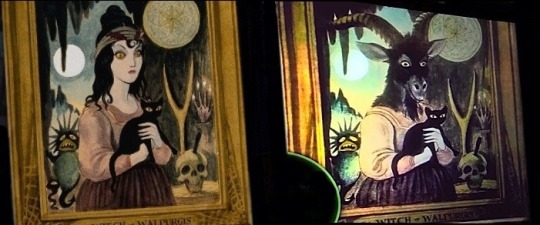
Long forgotten changing portraits, intended for the haunted mansion, but never made it into the final ride. By Marc Davis.
10K notes
·
View notes
Text
Death is a Cabaret, Old Chum...
Time to get our noses out of the Ancient Near East and back into the Victorian era, where we find more direct sources of inspiration for the Haunted Mansion. Back HERE I discussed briefly the Cabaret du Néant, with a link HERE to Cory's treatment of the subject, which is largely given over to quoting a lengthy passage from Bohemian Paris of To-day (J.B. Lippincott, 1900). It was written by W. C. Morrow from notes by Edouard Cucuel (the book also includes Cucuel's sketches). It's very good, very interesting, and a valuable source, but buyer beware; it's a second-hand account, and in places it's inaccurate. However, there are descriptions of the C du N published in other sources too, plus a lot of photos.
There is little doubt in my mind that the Cabaret du Néant was a direct source of inspiration for the Haunted Mansion. My reasons for thinking so will emerge with a fresh description of the Néant experience, drawn from several sources, as well as a closer look at the special effects used in the Néant show. I do not think these tricks have ever been explained accurately, so if you think you know the Cabaret well enough already—think again.
A bit of background. The pub originally opened in Brussels in 1892 as the "Cabaret de la Mort" (i.e. the Cabaret of Death), but it soon moved to the Montmartre district of Paris, where it was renamed the "Cabaret du Néant" ("néant" = nonexistence, obliteration, nothingness, death). The Montmartre district was THE place to be if you were an artiste in the second half of the 19th c. It seems like all of the important Impressionist painters lived there or hung out there. In the 1890's, it was bursting at the seams with cabarets and theaters, including fully-themed nightclubs. Practically across the street from the Cabaret du Néant, for example, were the "Cabaret of Heaven" and the "Cabaret of Hell," side by side. The waiters dressed as angels in the former and devils in the latter. Guess which one this is:
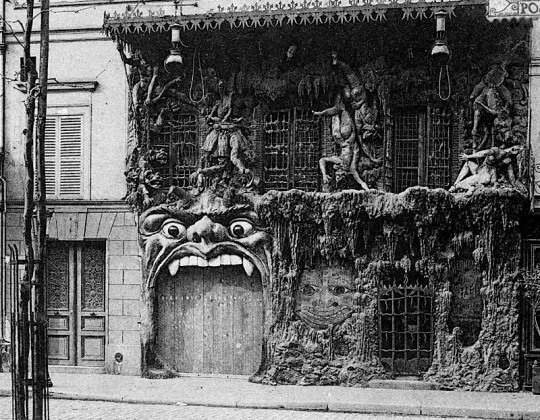
The famous Moulin Rouge cabaret is still there, but otherwise these pubs and theaters are all gone.
. . . Come to the Cabaret.

Shall we pay a visit? Oh, do let's. The street façade of the CdN is like a house dressed for mourning in traditional French fashion, with austere black and white coverings, although there is a skull and crossbones on the front door. There are two large, iron, torch-like lamps throwing yellowish-green light down on all who pass by. That kind of colored light makes people look shockingly sick and corpse-like, so we're already getting in the mood.
The unsmiling doorman is dressed exactly like a croquet-mort; that is, a professionalpall-bearer or undertaker's assistant. The same is true for the waiters inside.

The doorman leads you through the low, narrow front door and down a short, dark corridor. He opens some black drapes, allowing you to enter the first room. It's dark, lit only by candles. A chandelier in the center of the room is constructed of (real) human bones and nicknamed "Robert Macaire's chandelier," Macaire being a sort of all-purpose villain and bogeyman in France. Upturned coffins serve as tables, with small thin candles available for illumination.
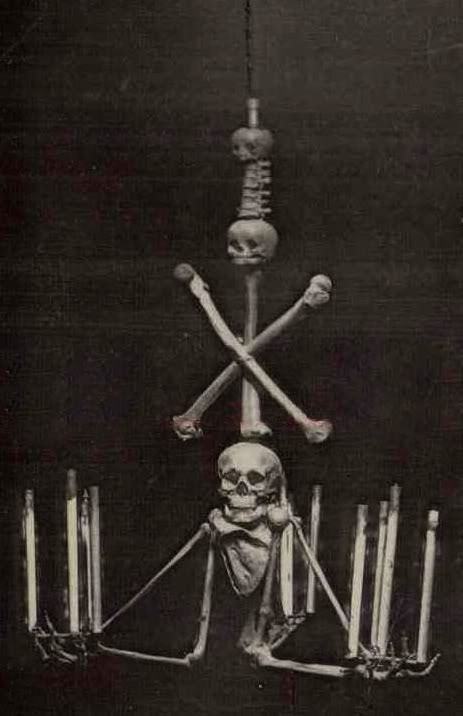
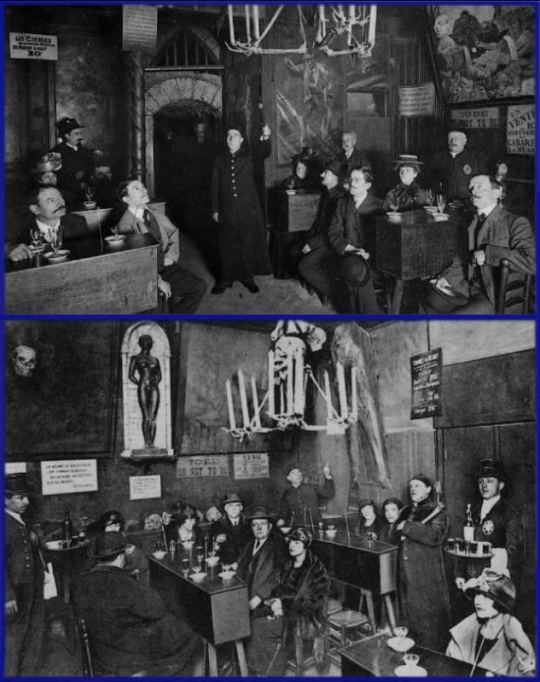
The walls are decorated with skulls (which serve as dim lamps), sculpture, and posters with grim slogans such as "Life is a folly which Death corrects," "To be or not to be," and "Requiescat in Pace," as well as No Smoking signs, price lists, and notices that candles are available for 10 cents. More importantly, there are paintings all over the walls depicting death and carnage. Battle scenes, a guillotine in action, and in later times, a painting of an automobile with a demonic driver, running people down—at least I think that's what this is:
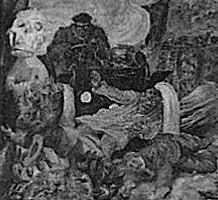
It's similar to a cartoon that appeared in Punch, in 1903:

(hat tip to Craig Conley)
By the way, this was actually a common theme among cynics and satirists in those days. These new-fangled automobiles were extremely dangerous, to the point that they betrayed a contemptible indifference to human (and other) life. They were depicted as instruments of death, glamorous only to the foolish and the callous. Here's a wonderful example from Puck. Behold the demon, "Speed Mania":

(Puck 68/1756, Oct 26, 1910)
Anyway, back to the Cabaret. Upon entering the room, you are met with "Welcome, moribunds," or "Welcome, weary wanderer, to the kingdom of Death," or "Enter, mortals of this sinful world, enter into the mists and shadows of eternity," or some other greeting striking the same tone as "Welcome, foolish mortals." Better get used to it. You and your friends will be continually addressed as "mortals," "coffin worms" (asticots de cercueil), and "Maccabees," the latter term being a slang expression for anonymous cadavers found floating in the river. In an account from 1931, it says that the staff at that time received guests by chanting a mass for the dead. The staff are all instructed not to smile or do anything else to break the solemn atmosphere, much like HM butlers and maids. That includes the waiter, who seems to mean it when he says "Name your poison." The mixed drinks and the beer are all renamed after deadly microbes and bacteria of various diseases. The waiter will plop them down before you, saying something like, "Drink, coffin worms. Drink these loathsome poisons filled with the deadliest germs."
A man in clerical garb eventually enters and gives a lengthy speech in morbid detail about the horrors of death, progressing from the variety of gruesome and agonizing ends awaiting individuals to the miserable fates of mankind in general.
Here the place gets interesting.
As he commences this portion of the lecture, the speaker points to a painting depicting a battle scene. According to Morrow, it begins to glow, making its details clear (remember, it's pretty dark in there). Then the glow fades away, and the painting has changed. The human figures in it are now all skeletons. The same thing happens with a painting of a guillotine chopping away. When the glow fades, the figures are now skeletons. Another painting shows a festive ball. Glow and fade. Now the dancers are all skeletons.
In my earlier treatment I quoted without objection Albert Hopkins' explanation of this effect (written in 1901). He suggests that the paintings are transparencies with one scene painted on one side and another on the other, the second one becoming visible when illumined from the rear. I now think that explanation is inadequate. It doesn't really account for the effect as described by Morrow. The paintings light up and then fade back down, revealing a skeletonized version of the same scene. How would you do that with a single, two-sided cloth? The effect could be produced, however, by having two paintings layered very close to each other, much like the panes in a double-pane window.

The skeleton one is in front, painted on a thin cloth or on theatrical scrim. The "normal" one is in back. The paintings are already moderately illumined from the back when folks come in, showing the back painting through the transparent front one. The lighting is further turned up during the lecture, at the appropriate time, and then faded down and extinguished, leaving the front painting visible for the first time. This would be perfectly do-able in the 1890's (the CdN was fully electrified).
In that earlier post, I drew a parallel between the CdN changing-painting effect and the attic wedding pictures and portrait hall paintings of the HM. If the above explanation is acceptable as a more satisfactory accounting for the effect as described, then the parallel between the Cabaret du Néant and the current Disney versions is extremely close indeed.
If you bought a drink while in the first room, you got a ticket entitling you to enter the Chambre de la Mort. You now take your puny candle and follow a man in Capuchin monk's garb single file through an arched doorway (painted to look like stone), down a narrow flight of steps, with green and yellow lighting once again, making everyone look cadaverous.

At the end of the steps is an antechamber where you wait your turn. The show repeats about every half hour, and only 15 or 20 are admitted at a time. To amuse yourself while you wait, you can look through holes or niches in the brickwork at gruesome tableaux, "studies of cholera patients, of persons buried alive, and similar cheerful subjects" (NYT Apr 9, 1894). Morrow (Cucuel) speaks of "bones, skulls, and fragments of human bodies." At last a cowled figure with only his eyes visible comes in and produces a large iron key, unlocking the spiked iron gate at one end of the room and opening it with a harsh grating sound. The monks mournfully announce that you have arrived at the Gates of Death, and in you go. There is an item inside, near the entrance: "By a clever arrangement of mirrors one sees one's self on entering reflected lying in a coffin" (NYT '94), which seems like a good idea since you can then see for the first time what you yourself look like under greenish-yellow lighting.
This part of the Cabaret du Néant show is justly famous. An upright coffin is visible in a narrow doorway at the far end of the room, which was hung in black in early years but later on left exposed, having been painted to look like stone vaulting. Also in early years, a pretty young lady was already in the upright coffin when you came in. She would smile and wink and then grow silent. While the monk guide kept up his groaning soliloquy about death and decay, she turned into a decaying corpse and finally a skeleton, right before your eyes. The process was then reversed, but instead of the young lady a fat old man returned. He would leave the coffin, and the monks would ask for a volunteer from the audience who would like to experience death. In later times they went straight to this phase and skipped the earlier stunt. Not missing a single detail, the Cabaret folks have a harmonium and an iron bell offstage somewhere, providing dirge music and solemn tolls at appropriate times.
There are a lot of pictures of this trick.


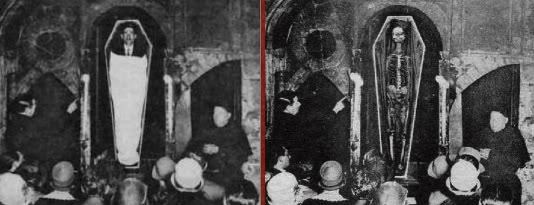
I especially like this last set because it really shows the excellent trompe l'oeil work in this chamber, transforming blank wall into convincing arches and stonework through skillful use of the paintbrush.

The trick is done, of course, using the Pepper's Ghost illusion, which requires only a big sheet of glass and careful manipulation of the lighting. But here again, I think Albert Hopkins' explanation is inadequate. He's got a simple two-chamber set up, turning the coffin occupant into a skeleton and back again. With this arrangement, the sense of gradual transformation would be enhanced through the use of colored light. The light on the volunteer goes from normal to greenish-yellow before fading down, while the skeleton is gradually lit up.
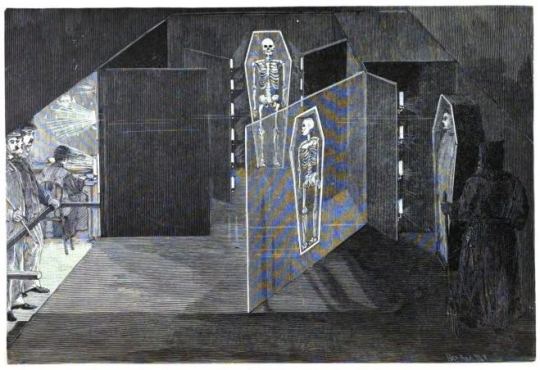
Below is a simplified pair of diagrams. When the coffin-with-occupant (#1) is illumined and the coffin-with-skeleton (#2) is dark, the audience sees only the first. When coffin 1 goes dark and coffin 2 is lit up, you see only the second, but it looks like it's in the place of the first. This is simple, rudimentary Pepper's Ghost illusioneering.


The problem with the Hopkins arrangement is that it does not account for the descriptions of the effect. Morrow describes a slow dissolving of the face into a corrupt state of decomposition before finally becoming a dried skull:
Her face slowly became white and rigid; her eyes sank; her lips tightened across her teeth; her cheeks took on the hollowness of death,—she was dead. But it did not end with that. From white the face slowly grew livid...then purplish black.... The eyes visibly shrank into their greenish-yellow sockets. ...Slowly the hair fell away....The nose melted away into a purple putrid spot. The whole face became a semi-liquid mass of corruption. Presently all this had disappeared, and a gleaming skull shone where so recently had been the handsome face of a woman.
Well, Morrow is giving a flowery, second-hand description based on Cucuel's notes, so maybe this is all exaggerated. But the 1894 New York Timesaccount also describes a three-stage process, although the stages are different: man, skeleton, vacant. The shroud on the volunteer "by some trick gradually melted away, so did the flesh, or rather the man in the coffin, and a skeleton appeared in his stead. There remained another experiment to be witnessed, namely, the crumbling away to dust of the bones."
There may even be a photograph of the intermediate, rotted-corpse stage as described by Morrow:
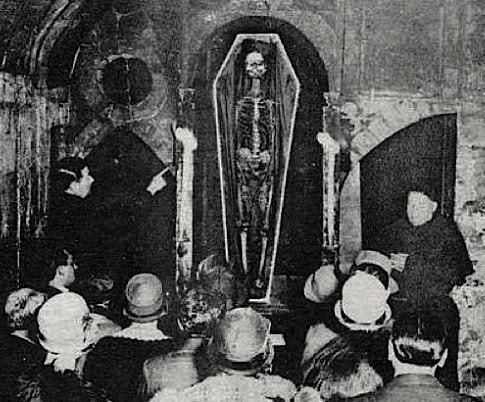
The CdN gang may have had a much more sophisticated set-up than Hopkins describes. One possible way to add a step to the transformation is with two sheets of glass and a third, intermediate coffin.
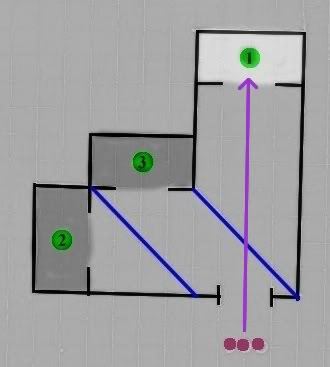
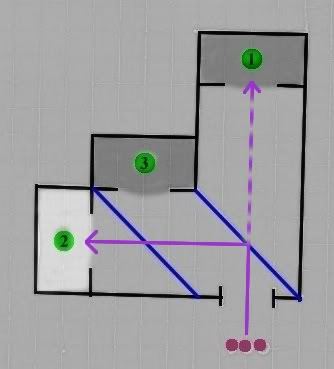

For an alternate method, still using only a single glass, see the remarks by "John b" in the Comments (Aug 4, 2013). It involves rotating, back-to-back coffins. The only problem I see with it is that it would be hard to use genuine audience volunteers that way. You'd probably need stooges.
Why so fancy? By the 1890's, Pepper's Ghost trickery had been in use for thirty years. The Cabarets of Heaven and Hell, across the street from the CdN, used it in their floor shows. Various traveling ghost show exhibits and theaters made heavy use of it, and Professor Pepper himself kept flogging it at the Royal Polytechnic Institute where he worked.


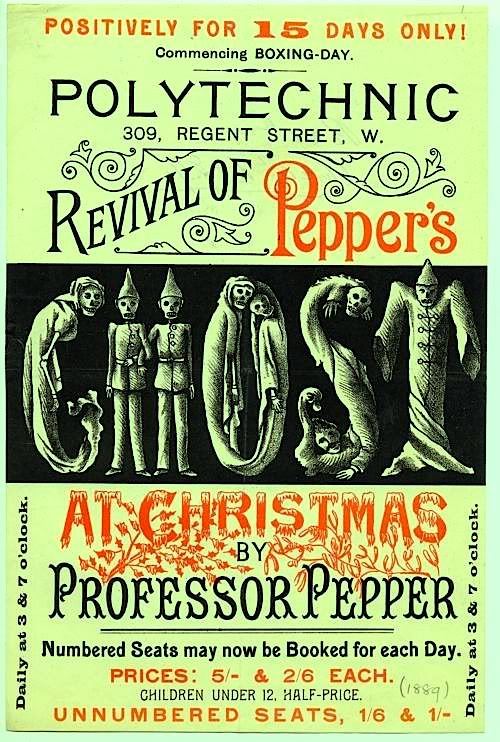
Furthermore, there was no shortage of Victorian spoil-sports eager to inform the public how the illusion was done:

It stands to reason that showmen would be searching for clever new ways to use what was now an old-hat illusion, something to bring back the "how do they do that?" element. The CdN boys seem just the kind who would tackle such a problem. Besides, two-sheet Pepper's Ghost illusions were known, even if this illustration doesn't show them making any particularly good use of it.

Originally, the coffin gag was the end of the show at the CdN, but in 1900 or 1901 they added a whole third room, set up like a small theater, with another Pepper's Ghost illusion onstage.

This one was played strictly for farce, to judge by descriptions and photos. The poor volunteer could not see what the audience saw: ghosts moving around, mocking, doing stupid bunny tricks, acting in a lewd and lascivious manner (this is Paris, after all). "[T]he solemnity which the lecturers invoke is of a most mock sort, and the audiences are continuously convulsed with laughter" (NYT 1896). Time to go.

Rolly Crump and Yale Gracey were professional magicians, as noted in an earlier post, and they did research into things like the history of Pepper's Ghost. There can hardly be any doubt that they knew about the Cabaret du Néant, which is mentioned in any decent survey of Pepper's. Earlier, Ken Anderson had incorporated a Pepper's Ghost illusion in his proposed haunted house walk-thru, using a 45º angled glass pane, much like CdN:
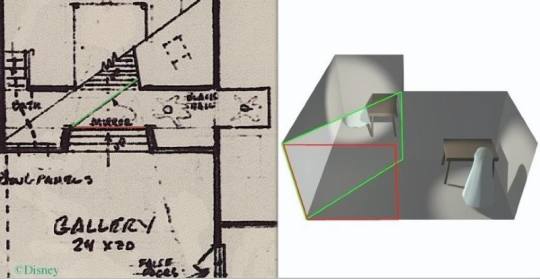
Eventually, this horizontal version of Pepper's would be used in Phantom Manor to make Melanie appear in the Endless Hallway. By the way, the CdN coffin gag was reproduced very closely, except it wasn't at Disneyland but at Knotts Berry Farm:

Besides the technical gimmicks, the CdN used a winning recipe of horror + stage magic + laughs, essentially the formula used for the Haunted Mansion.
Some time in the 1930s the Cabaret moved to a different location on the same street (#64 instead of #34) and continued to operate there for a long time. In November of 2012 we made a major discovery: The Cabaret du Néant was still open in September of 1969, in other words, still operating when the Haunted Mansion opened.
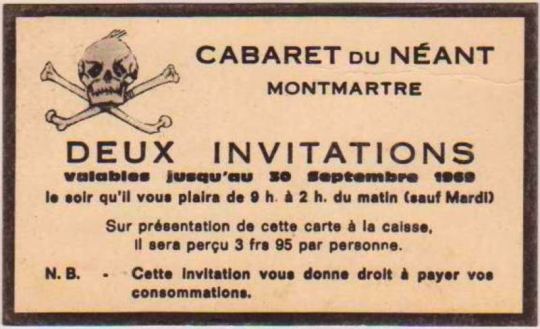
As a postscript, I should mention the apparent discrepancy between the photos of the coffin gag, in which the coffin looks like it's standing right in the doorway, and the actual set-up, which had it much further back. It's simple: these are staged photos, intended for post cards and publicity. They moved the coffins up for the photo shoots.
Originally Posted: Tuesday, August 24, 2010
Original Link: [x]
11 notes
·
View notes
Text
Cherubic Gateways

[Post Script added, July 2017]
A few posts back we discussed the gryphons at the foot of the stairs. I said that they were like sentinels at the gateway to the unknown, "and that sort of thing." Well, today we plunge headlong into "that sort of thing." We've been schlepping around in the 19th and early 20th centuries looking for things that might have inspired the Imagineers. In this case, however, they are probably not taking inspiration from some specific source so much as they are making use of symbolism that must be measured by millenia rather than a few paltry centuries.
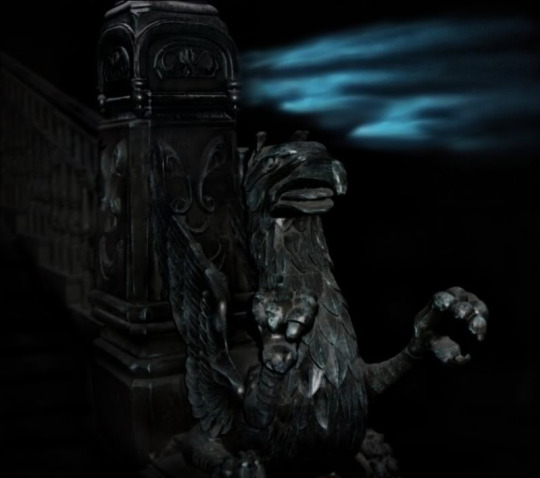
What does it mean to pass between a pair of gryphons? So glad you asked. The place between these creatures is a place of terrible and supernatural power. You often find them on the arms of thrones, in the form of cherubim. Oh yeah, I guess we'd better deal with the terminology thing first. In general:
Lion body, human head = Sphinx
Lion body, human head, eagle wings = Cherub
Lion body, eagle head, eagle wings = Gryphon
But there's a lot of slop in those terms, even among scholars and archaeologists. Most of the time, for all practical purposes, they're more or less the same creature. Interestingly, some linguists think "gryphon" is derived from "cherubim" (which is the normal Hebrew masculine plural form of "cherub"; it's one cherub, two cherubim).
G R PH N
CH R B M
Those are all plausible consonantal transmutations when a word travels from one language to another. Now pardon me for a moment while I get this out of my system. How these pudgy little atrocities picked up the name "cherub" is beyond me.
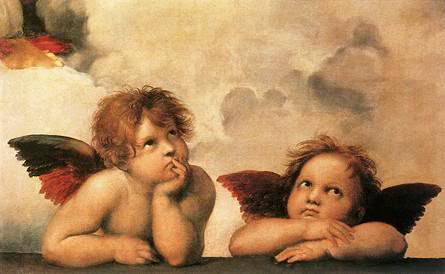
Gag. Wretch. Drat, there's never a neutron bomb around when you really need one, is there?These pests are found in Western art only. Eastern Christian cherubim remain properly terrifying.
Okay, I feel better. Now back to cherubic thrones. Those hail from the Ancient Near East, and "ancient" is what they certainly are.
Here's an ivory from Megiddo, ca. 1250 BC, give or take a century.

From the sarcophagus of Hiram, king of Tyre, ca. 1000 BC.

It's not rocket science. The animals represent gods, and they are guarding the king, who is practically on a par with the gods themselves. The king is seated upon the cherubim, which may ring a bell with the biblically literate among you, since God is seven times described as seated upon the cherubim (1 Sam 4:4; 2 Sam 6:2; 2 Kgs 19:15; 1 Chr 13:6; Pss 80:1; 99:1; Isa 37:16). It's very much a royal image. In the Holy of Holies in Solomon's Temple in Jerusalem, there were two HUGE cherubim, with the Ark of the Covenant between them and in front of them. (The Ark also had a small pair of them on its cover, as any Indiana Jones fan can tell you.) God cannot be seen, but he was apparently understood to be seated upon the cherubim, and the Ark was his footstool (footstool?!? yes, footstool; see Ps 132:6-7; 1 Chr 28:2). The high priest entered and stood before the Ark, in the actual presence of God, once a year, in pitch darkness, protected only by a heavy cloud of incense smoke. He had bells on the fringe of his robe so they could hear if he was still moving around; that is, had not DIED. In later times they tied a rope around his ankle so they could drag out the corpse if something went awry.
Powerful images, and part of our psychic inheritance, whether you're a believer or not.
Sometimes the cherubim are gryphons, in line with the fluid interchangeability of these creatures. Here's a good example from an Assyrian cylinder seal, ca 700 BC. Two gryphons flanking a god.

And we still use them in royal or supernatural settings. If you've got sharp eyes, you'll spy such a chair in Cocteau's La belle et la bête (1946), a film that profoundly influenced Rolly Crump, as many of you know.

It's no surprise that Caesar is sitting on a chair of this type, as we have seen before. He is, after all, Caesar. (How the birthday girl gets away with standing on one of these, however, is beyond me.)
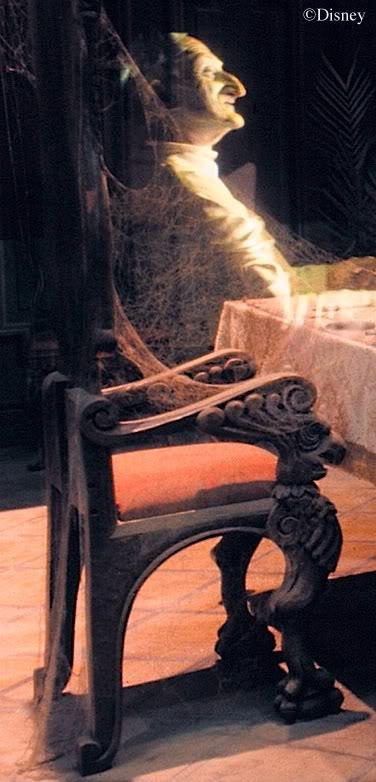
But thrones aren't the only option for cherubic pairs. In the iconography of the Ancient Near East they may simply stand on either side of a god or a king—in these two examples a sun god and a prince.


They can also stand like sentinels at the gateway leading to the royal presence, as in this Assyrian example. (For their cherubim, the Assyrians preferred a bull's body to a lion's. Regional variations, blah blah blah.) These have now been destroyed by ISIS.

And with that one, the symbolism approaches our home base.

And...so what? I'm just pointing out that in some places the HM traffics in cultural symbols with astonishingly long pedigrees, and that longevity owes something to the power of those symbols to evoke even today a sense of the supernatural, a sense of fear and awe.
Post Script (July 2017)
By the way, I'm not implying that the Imagineers were boning up on Mesopotamian iconography and drawing inspiration directly from there. It's more a matter of pulling up something that's been implanted in our psyches for millennia. If we want to look for a more immediate inspiration, one possibility (and that's all it is) might be the staircase in the old Munsters TV show, which also had a pair of gryphons at the foot of the stairs:
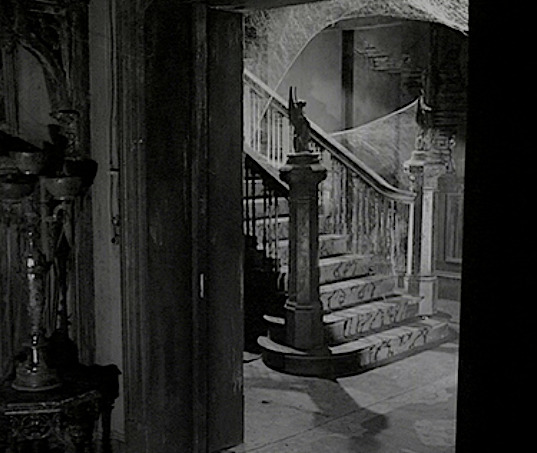


Originally Posted: Wednesday, August 18, 2010
Original Link: [x]
11 notes
·
View notes
Photo
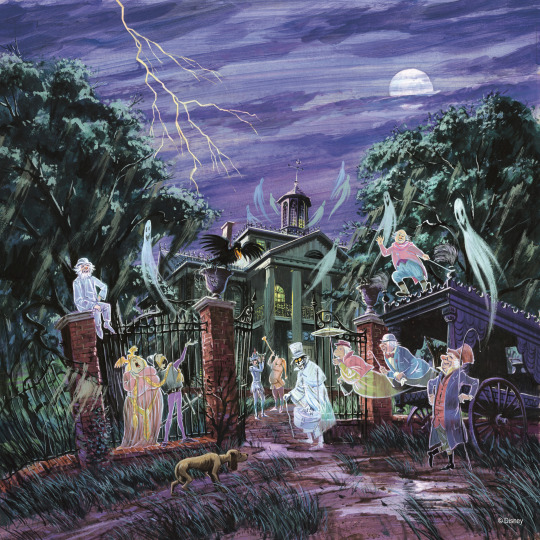
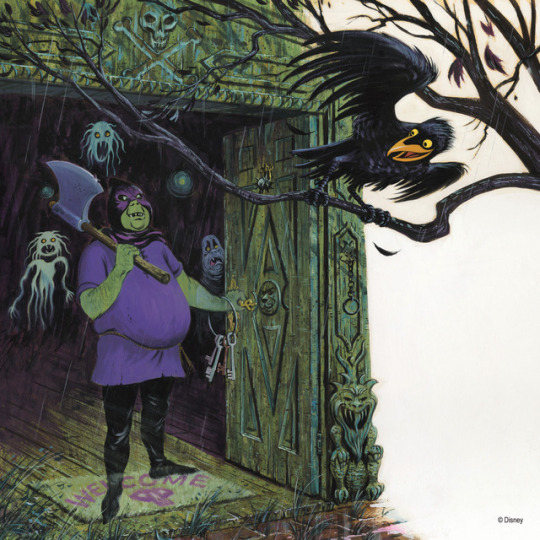



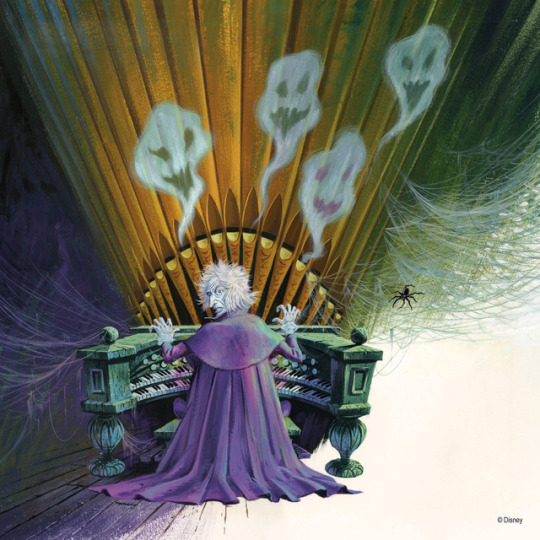
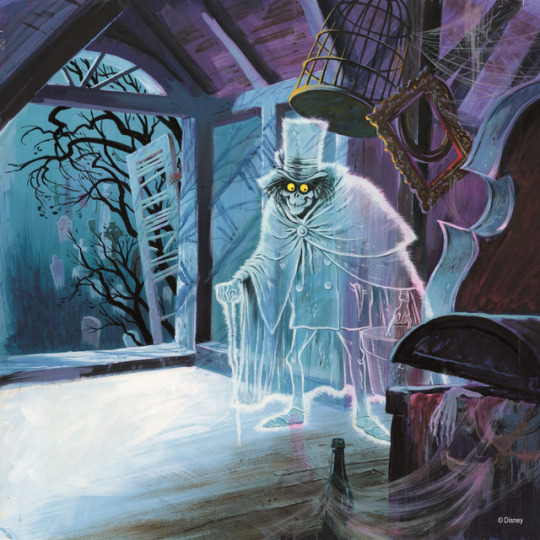



The Story and Song from the Haunted Mansion, 1969
30K notes
·
View notes
Text
When the Spooks Have a Midnight Jamboree
They say that whatever music you loved when you were 17, that's the music you will love the rest of your life. For Buddy Baker, who wrote the music for the Haunted Mansion, that would be 1935. For X. Atencio, who wrote the lyrics to "Grim Grinning Ghosts," it's 1936. That's just an interesting factoid to keep tucked away as you read what follows.
No one doubts that a big part of the Mansion's appeal is its superb musical scoring. The "Grim Grinning Ghosts" tune, written by Buddy Baker, appears in numerous arrangements throughout the ride, and however much it's rearranged and recast, it always sounds creepy. Magic!
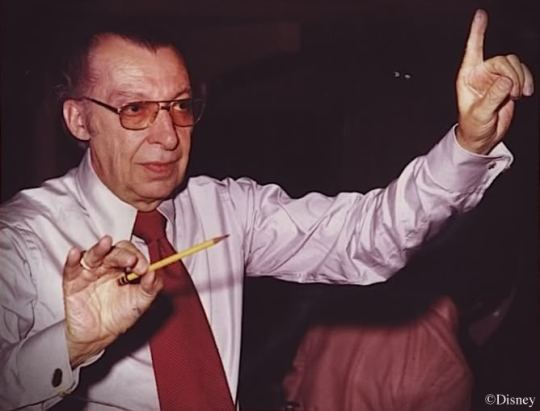
The lyrics are not exactly Shakespeare. Actually, the title is Shakespeare. The phrase "grim grinning ghost" appears in line 933 of the epic poem, "Venus and Adonis."
"Hard-favour'd tyrant, ugly, meagre, lean,
Hateful divorce of love,"—thus chides she Death,—
"Grim grinning ghost, earth's worm, what does thou mean
To stifle beauty and to steal his breath,
Who when he liv'd, his breath and beauty set
Gloss on the rose, smell to the violet?
Too bad it wasn't in line 999. Whether X borrowed the phrase consciously and deliberately or plucked it from a subconscious memory of his readings in Shakespeare—who knows?
Anyway, there is no point in pretending that the lyrics are poetry with a capital P. The graveyard jamboree scene (the only place you hear the lyrics sung) is not conducive to hearing a song with any kind of narrative. "Grim Grinning Ghosts" is calculated so that someone can hear a line here or a piece of a phrase there and still get the general idea of ghosts and ghoulies coming out to party. Except for the tagline at the end of each verse, you could almost put the rest of the lines in a hat and reorder them at random. [Edit 8/13: But see now the argument by T. Hartwell in the Comments.] The song is a laundry list of spooky phenomena, explained at the end of each verse as ghosts coming out to socialize. The arrangement is suitably rollicking and undeniably catchy:
Grim Grinning Ghosts
[Audio Link]

Grim Grinning Ghosts
When the crypt doors creak and the tombstones quake,
Spooks come out for a swinging wake.
Happy haunts materialize,
And begin to vocalize.
Grim grinning ghosts come out to socialize.
Now don't close your eyes and don't try to hide.
Or a silly spook may sit by your side.
Shrouded in a daft disguise.
They pretend to terrorize.
Grim grinning ghosts come out to socialize.
As the moon climbs high o'er the dead oak tree,
Spooks arrive for the midnight spree.
Creepy creeps with eerie eyes,
Start to shriek and harmonize.
Grim grinning ghosts come out to socialize.
When you hear the knell of a requiem bell,
Weird glows gleam where spirits dwell.
Restless bones etherialize,
Rise as spooks of every size.(Laughter)
Incidentally, those singing busts have official names, which are on the blueprints and the film strips for each one (before things went digital). Left to right you've got Rollo Rumkin, Uncle Theodore, Cousin Algernon, Ned Nub, and Phineas P. Pock. We've already met Rollo and Phineas as tombstones in the original outside queue. "Cousin Algernon" is the name of a character in the Oscar Wilde play, "The Importance of Being Earnest." There was originally going to be a sixth bust, Aunt Lucretia, but they went with an all-male chorus, and Aunt Lucretia found useful employment elsewhere in the Mansion.

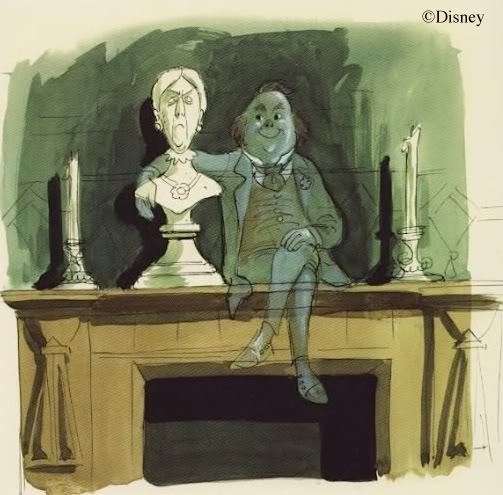

But let's get back to our topic. When it comes to comic songs about ghosts and goblins coming out to party, the first one that comes to most people's minds is probably "The Monster Mash," but long before that record came out the theme was popular. In fact, the heyday of such songs was the 1930's and 40's. If you listen to some of those, you're probably hearing the inspirational roots that led to GGG. Put another way, GGG is part of an established genre of novelty songs rooted in the 30's and 40's. At times, the lyrics to some of these songs come so close that you could almost suspect direct inspiration, but there are no smoking guns that I know of. Nevertheless, I've highlighted a few such lines in what follows. These songs are a real kick to listen to, whatever the excuse for doing so.
The Skeleton in the Closet
[Audio Link]
There's an old deserted mansion on an old forgotten road,
Where the better ghosts and goblins always hang out.
One night they threw a party, in a manner à la mode,
And they cordially invited all the gang out.
At a dark bewitching hour, when the fun was loud and hearty,
A notorious wallflower became the life of the party.
The spooks were having their midnight fling,
The merry making was in full swing,
They shrieked themselves into a cheerful trance,
When the skeleton in the closet started to dance.
Now a goblin giggled with fiendish glee,
A shout rang out from a big banshee,
Amazement was in every ghostly glance.
When the skeleton in the closet started to dance.
All the witches were in stitches, while his steps made rhythmic thumps,
And they nearly dropped their broomsticks when he tried to do the bumps.
You never heard such unearthly laughter, or such hilarious groans,
When the skeleton in the closet rattled his bones.
That's Satchmo himself, of course, Louis Armstrong, from the soundtrack of the 1936 film, Pennies from Heaven. The similarity of theme between "Skeleton" and GGG is obvious.
Swingin' at the Séance
[Audio Link]
In a house up on a rock along the countryside,
At precisely twelve o’clock the spooks begin to rise.
Swingin’ at the seance, twelve ticks,
Swingin’ at the seance, hot licks,
With the medium in trance,
How that horn began to dance.
Swingin’ at the seance, five men,
Swingin’ at the seance, jive men,
When the trumpet blasted out,
All the spooks began to shout.
That music came through so sweetly low-down,
Yet nobody knew who was riff-riff-riffin’ around.
Swingin’ at the seance, black coats,
Swingin’ at the seance, blue notes,
While the trumpet could have won a cup,
Its jivin’ broke the seance up,
And who do you think was a riffin’ away?
No one else but Billy May.
That's the Glenn Miller Orchestra, with Dorothy Claire, in 1941. Looks like it may have been written by Billy May.
The Headless Horseman
[Audio Link]
Now, gather ‘round while I elucidate
On what happens outside when it gets late.
‘Long about midnight the ghosts and banshees
Get together for their nightly jamboree.
There’s ghosts with horns and saucer eyes,
And some with fangs about this size.
Some short and fat, some tall and thin,
And some don’t even bother to wear their skin.
I’m a-tellin’ you brother, it’s a frightful sight
Just to see what goes on in the night.
When the spooks have a midnight jamboree,
They break it up with fiendish glee.
Ghosts are bad, but the one that's cursed
Is the Headless Horseman, he's the worst.
When he goes a-joggin' 'cross the land,
Holdin' a noggin in his hand,
Demons take one look and groan,
And hit the road for parts unknown.
And there's no wraith like a spook that's spurned.
They don't like him, and he's really burned.
He swears to the longest day he's dead,
He'll show them that he can get a head.
So close all the windows, lock the doors,
Unless you’re careful, he’ll get yours.
Don’t think he’ll hesitate a bit,
‘Cause he’ll flip your top if it’ll fit.
And he likes them little, likes them big,
Part in the middle, or a wig,
Black or white or even red,
The Headless Horseman needs a head.
With a hip-hip and a clippity-clop,
He's out lookin' for a top to chop,
So don't stop to figure out a plan,
You can't reason with a headless man.
So after dark he’ll get the goods.
Head home, the way that you should,
‘Cause right outside, a-waitin’ there,
Is the Headless horseman. Beware!
Now we're closer to home. This was sung by Bing Crosby in Disney's The Adventures of Ichabod and Mr. Toad (1949). Nothing at all against Bing, but I prefer this version by Kay Starr, released only a few months after the original Crosby version. Kay's lyrics are slightly different, as you can see, since I've printed the BC version. When she and those background singers get to "...what goes on in the nighhhhht" you know you got your money's worth for THAT record.
The Haunted House
[Audio Link]
When the doors all squeak
And the windows creakAnd the ceilings leak
‘Cause the roof’s antiqueAnd you hear a shriek
And your legs feel weak—
It’s a haunted house
There’s a dismal moan
Like a weird trombone
And the old hambone
Is suddenly thrown
You are all alone
With the great unknown
In the haunted house
There’s only one good spirit, it’s the spirit in the bottle.
With shaking hands you pull the cork and pour some down your throttle.
There’s a clank of chains
And a smell of brains
And a gory stain
Where the Duke was slain
And you’ve got chilblains
And varicose veins
In the haunted house.
When the old oak beam
Feels a corpse [?], you seem
To feel a wet stream
With a sinister gleam
And you wake with a scream
From a horrible dream
Of the haunted house.
When the cavalier
With the dreadful leer
Tried to disappear
Through the chiffonier
And you cling with fear
To the chandelier
It’s a haunted house.
The air is full of clammy claws that clutch you by the collar.
So gargle night and morning just in case you have to holler.
There are lights and sprites
And awful frights
In flesh-pink tights
But the dead of night
Comes a woman in white
So you’re quite all right
In the haunted house.
When the old church clock
Strikes twelve, there’s a knock.
With a sudden shock
You remember the lock
On the door is a crock—
Oh, why did you mock?
At the haunted house.
It is black as pitch
And your eyeballs twitch
In the darkest niche
Sits a dirty witch
And the lighting switch
Is out of reach
In the haunted house.
When the slavey’s filled with gravy why is she so pallid?
Something pushed her in the pantry when she fetched the salad.
“I’m filled with dread.
Yes I’m nearly dead.
I saw a head
Underneath my bed.
Come out if you can.
I could do with a man
In the haunted house.”
That's the oldest one of the bunch (almost: see below). 1931, Ray Noble and the New Mayfield Orchestra. It's British, and there are a couple of pop culture references in there that are hard to decipher at this distance. "Slavey" is slang for any menial servant. What the flesh-pink tights are all about, I don't know [Edit: see comments]. The opening line is startlingly like GGG, and the structure of the song is similar: a litany of spooky phenomena with an explanatory line repeated at the end of each verse. No partying spooks in there, however.
This list could easily be extended by quite a bit. You can buy a whole CD full of these '30s-'40s novelty ghost tunes. But you get the idea. "Grim Grinning Ghosts" features a contemporary arrangement (for 1969), but it feels right at home with some of these old chestnuts, don't it?
Reader Melissa has directed our attention to a Gilbert and Sullivan ditty that may be the granddaddy of all these songs, and as it happens, it's a very good match to GGG in a number of ways. The laundry list of spooky phenomena followed by an explanatory final line. The topic? Ghosts having a midnight jamboree. The repeated lines at the end of each stanza explain that to us. This is a lot like GGG.
When the Night Wind Howls
by: W.S. Gilbert (1836-1911)
When the night wind howls
In the chimney cowls,
And the bat in the moonlight flies
And the inky clouds
Like funeral shrouds,
Sail over the midnight skies--
When the footpads quail
At the night-bird’s wail,
And black dogs bay at the moon,
Then is the spectre’s holiday--
Then is the ghost’s high noon!
Ha! Ha!
Then is the ghost’s high noon!
As the sob of the breeze
Sweeps over the trees
And the mists lie low on the fen,
From grey tomb-stones
Are gathered the bones
That once were women and men,
And away they go,
With a mop and a mow,
To the revel that ends too soon,
For cock crow limits our holiday--
The dead of the night’s high noon!
Ha! Ha!
The dead of the night’s high noon!
And then each ghost
With his ladye-toast
To their church yard beds take flight,
With a kiss, perhaps,
On her lantern chaps,
And a grisly grim, “good night!”
Till the welcome knell
Of the midnight bell
Rings forth its jolliest tune,
And ushers in our next high holiday--
The dead of the night’s high noon!
Ha! Ha!
The dead of the night’s high noon!
W. S. Gilbert (1836-1911)
Taken from: Ruddigore: or, The Witch’s Curse (London: G. Bell & Sons, 1912)
We will revisit this song and go into greater detail in THIS post.
Originally Posted: Friday, August 13, 2010
Original Link: [x]
18 notes
·
View notes
Text
The Séance Circle Part Two: Davenports, Cabinets, and Other Furnishings
There's obviously a significant gap between the aquatic critters and bat-winged cats flying around St. Anthony's head in an old painting reproduced in an old book on the one hand and a Marc Davis concept sketch for the Haunted Mansion Séance Circle on the other, and there's another gap between that sketch and what eventually was built into the ride. By now, that's what we've come to expect around here. In many cases, the gaps are such that you can't recognize any traces of the original inspiration in the finished product.
Not here. Davis's squiddly creatures and airborne felines notwithstanding, for the most part the Séance Circle is the place in the Mansion where the line between source material and finished product is the thinnest. At times, the Imagineers merely reproduced an effect directly.
Hey, I wonder where they got the idea of hanging a bell by thin wires so it could float around overhead?

Call me crazy, but I think that possibly they got the idea from séances where a bell was suspended by thin wires so it could float overhead.
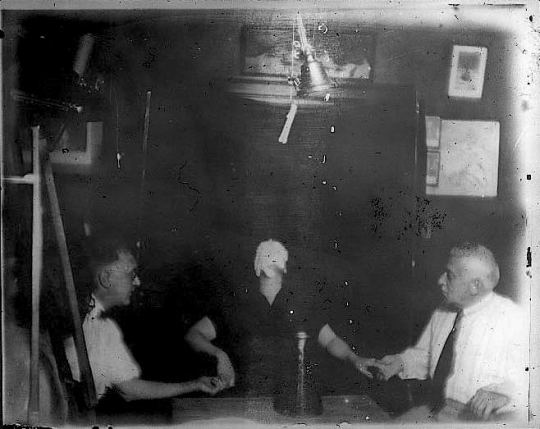
Our sources are 19th and early 20th century séances and ghost shows, of course. The period from about the 1850's to the 1920's was the heyday for mediums, spiritualists, and "spirit photography," as well as a heyday for theatrical and parlor magic shows—not coincidentally. It's hardly worth the trouble, for our purposes, to try to sort out the tangled continuum between real, sincere spiritualists and real, sincere attempts to contact the dead via séances at one end of the spectrum and openly-stated illusioneering for entertainment purposes by stage magicians (in the David Copperfield sense of the word) at the other end. There were those, and there was also everything in between. You had fraudulent mediums who insisted they were genuine even while admitting to using tricks now and then, and you had stage magicians who flatly denied they were mediums but also claimed that the ghosts they produced onstage were real. Harry Houdini was a famous skeptic and used his knowledge and expertise in professional stage magic to debunk spiritualists and mediums. These efforts did nothing to keep some people from believing Houdini was himself gifted with psychic powers. The blurring of lines makes sense if you think about it, since a good fraudulent medium is almost by definition a good illusioneer, a good magician.
Some of the Haunted Mansion Imagineers were card-carrying magicians (Yale Gracey and Rolly Crump), with a natural interest in all of that stuff. Is it really a surprise that apart from the spectacular Madame Leota effect (which nevertheless may owe something to 19th c. magicians like Harry Kellar), the main difference between the HM séance and a "real" 19th-early 20th c. séance is the fact that one is an honest fake while the other is a dishonest fake? Otherwise, they're both going about the same business: creating realistic-looking spiritualistic effects that could fool a gullible soul under the right circumstances. In fact, the HM version is historically realistic enough to require some annotation. And that's our job.
Begin with the ectoplasm ball floating around behind Madame L.
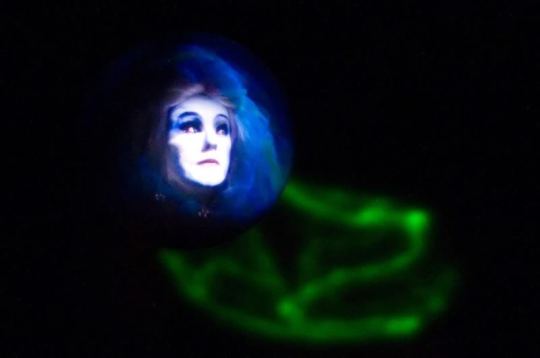
(pic by Jeff Fillmore, SCL photography)
Ectoplasm was commonly produced at séances, usually manifested as a white-ish substance oozing from somewhere on the medium's body. In photos it looks suspiciously like chewed up gauze or paper, and even if you're a true believer, those photos are embarrassments. Real eye-rolling stuff. There's some ecto on the face of the medium in that earlier photo. In "spirit photography," you sometimes saw ectoplasm leaving glowing trails. Not much different than the Disneyland version, really, even if they couldn't figure out how they wanted to spell "ectoplasm" on the Effects blueprints.

Even when the Disneyland version started making faces at guests early in 2006, they weren't departing from tradition, since faces often appeared in clouds of ectoplasm at the "real thing."

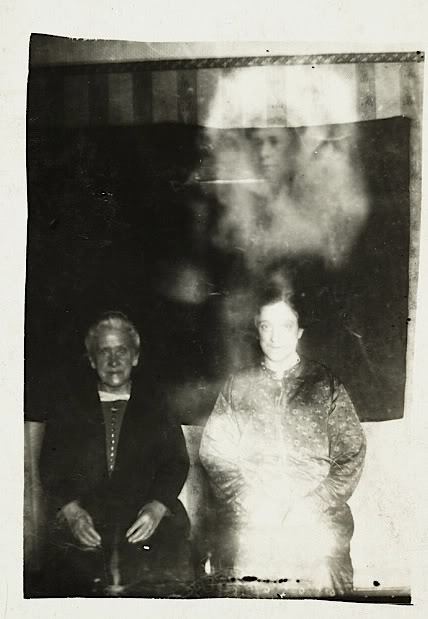
The Davenport Brothers
So far we've been talking about the 19th-early 20th c. phenomena in general. If there was a specific historical inspiration for the HM Séance Circle, it was the stage act put on by the Davenport brothers. These are the guys who disclaimed being mediums while suggesting that the ghosts were real. They started in the 1850's and were a very big act throughout the '60's. It all came to an end when one of the brothers died unexpectedly in the 70's.
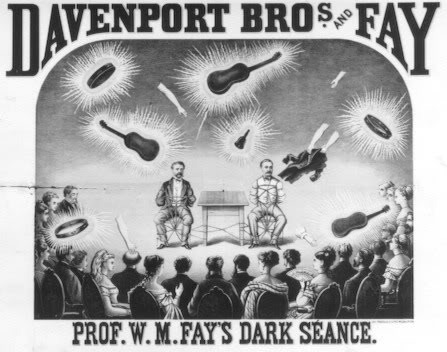
What they really were were top-notch escape artists and illusioneers, with an excellent staff of assistants who never got caught and never blabbed. The Davenports would be tied up good and tight, and then as soon as the lights went out musical intruments started flying around and ghostly hands and arms appeared, touching people and scaring 'em good. On with the lights, and there are the D bros, still tied up.
They invented the "spirit cabinet" for their act. It was a large cabinet in which they both sat, all tied up, sometimes with an audience member sitting between them. After the lights went out, the usual levitations and creepy manifestations followed.


It didn't take long for professional mediums to recognize the advantages of having a large cabinet to work with. The "spirit cabinet" very quickly became a standard fixture at séances. With perfectly straight faces the mediums spoke of the cabinet as a kind of "spiritual storage battery." Seriously. Most often, the "cabinet" was not a wooden chest but a tent or a booth in the corner of the room. The medium might sit in it or at its entrance or in front of it, while spirit manifestations appeared in front of the cabinet.

"And look how fast that button spins when I pull these back and forth!"

Wow, how do they do that?

Okay, nevermind.
It's easy to make fun of these phonies and the people taken in by such simple tricks, but many of these mediums were highly skilled magicians in their own right. It takes practice. I mean, how many people can control their urine stream like this?

Spirit cabinets are present at the Haunted Mansion séance, although it's doubtful if many guests recognize them for what they are.
Both types can be seen behind Madame Leota.

It originally looked more like this under show conditions, of course:

As previously noted, the Séance room in the Haunted Mansion is yet another idea that goes all the way back to Ken Anderson, and if I'm reading this sketch correctly, the novel idea that the medium is herself a ghost is also his. Notice that she is emerging from a spirit cabinet, already in this early concept artwork.

Just like the real thing.

Or the real real thing.

Hat tip to Craig Conley. From Puck magazine (1884), perhaps a political cartoon

But getting back to the Davenport brothers, we know about them mostly from written accounts, of course, and one famous description of their act appeared in the London Post. Compare the description of the musical instruments at a Davenport show with what we find in that earlier Davis sketch and in the inner circle of the actual attraction.

Floating tables, even high-flying, large tables, are nothing new to séances.

"Great Caesar's ghost, look at all the old gum wads!"
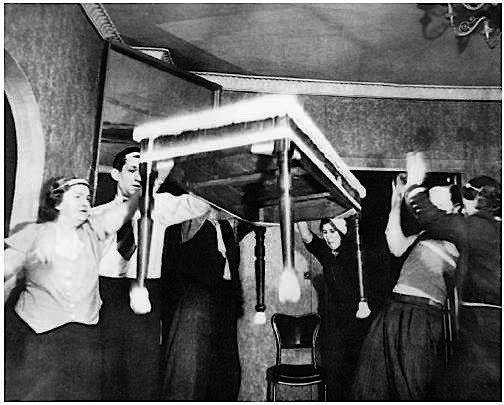
Marc may have wanted flying animals, but I think even he realized that furniture and musical instruments were more authentic. He still couldn't resist throwing in a cat, though.

The musical instruments are the more interesting feature. Madame Leota refers to most of them in her incantations, as you can see right there in her open spellbook . . .

. . . or hear isolated in this sound file:
Leota's Incantations in the Ride
[Audio Link]
That gives us a bell and a tambourine. For the horn, drum, and some kind of stringed instrument, we have to cite two incantations that were recorded but never used.
Leota's Incantations Never Used
[Audio Link]
Horned toads and lizards, fiddle and strum,
Please answer the roll by beating a drum.
Harpies and Furies, old friends and new,
Blow on a horn, so we'll know that it's you.
No one knows why these weren't used. It could be something as simple as a head movement during filming that misaligned the face at that point.
If you examine the instruments in the posters for the Davenport brothers, you'll see four kinds, the now-familiar horn, tambourine, and bell, plus something to "fiddle and strum," a guitar. It doesn't take much thought to see why the guitar wasn't kept for the HM séance. That instrument has undergone a complete reinvention in popular imagination since the 19th century and now has utterly different connotations. It is no longer even remotely associated with the exotic or the quaint.
Oddies and Endies, out of the past, come to us now, and we'll deal with you last.
We've noted the connections between the Séance Circle and its historical sources; now it's time to wrap up a few curious odds and ends.
Madame Leota's wooden spirit cabinet originally served a very practical purpose. It was going to house the projector that produces her face. Back then, she was going to face in the opposite direction. You would see her face as you enter the room and swing around behind her. This was the plan up until three or four months before the Mansion opened, at most. It was probably ditched because you wouldn't be able to prevent people from seeing the projector at some point as they went by.
Looking at the outer ring of floating objects, here are some random observations. The wicker table is part of a set, and other pieces from the same set have been kicking around in the Attic for years and years. The banner on the longhorn says "X = ?" I think it's a sly tribute to X. Atencio, or maybe they're teasing him ("X? What the heck kind of name is 'X' anyway?"). The gong was originally going to be a cluster of three bells. Oh, and you know that floating candelabra back in the Endless Hallway? It was originally supposed to be here in the Séance Circle.
The second drum has been missing at Disneyland for a long time. The last time it was certainly seen was in 1991.
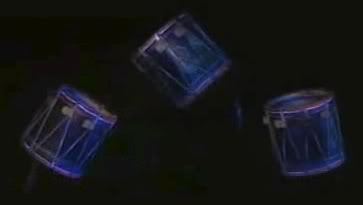
Perhaps it will show up on eBay some day.
Forget about the Phantom Drummer of Tedworth; what's the phantom drum overhead worth?
Originally Posted: Monday, August 9, 2010
Original Link: [x]
7 notes
·
View notes
Text
The Séance Circle Part One: A Real Fake, Not a Fake Fake
We are going to spend some time in the Séance Circle, one of the richest and most evocative rooms in the Mansion. According to our analysis, it's the eye of the storm, the center, the pivot, the Act Two that creates the transition from Act One to Act Three.
The Imagineers explored both spooky and whimsical approaches to the Séance Circle. Like so many features of the Mansion, this one goes back to Ken Anderson, who seems to have favored a creepy look.

This concept sketch by Dorothea Redmond, sometimes misattributed to Marc Davis (like for instance, moi in the original version of this post), is as darkly atmospheric as anything Claude Coats might have done.
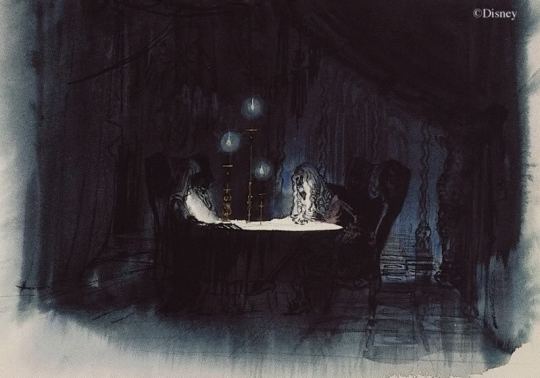
Our chief interest today, however, is in Marc Davis's concept art for the Circle.
Davis retained Ken's idea of having a séance scene, imagining a medium by the name of "Madame Z" presiding. Typically, Marc's approach was more whimsical. It may be pure coincidence, but this first sketch reminds me of the scene in The Sword in the Stone in which Merlin packs his bag. Davis did not work on that film, but it would have been Disney's second most recent animated feature at the time (behind Jungle Book). There are a lot of airborne items in Marc's sketch that are similar to what Merlin put up there.


This second sketch is full of interest. It has a head speaking inside the crystal ball, which is NOT something drawn from traditional fortune-telling craft but obviously foreshadows the direction they would go with that gag. For the items flying around above the table, this time we can point to some probable sources of inspiration much older and more remote than recent Disney films. We have already seen that Marc made direct use of Émile Grillot de Givry's Le musée des sorciers, mages, et alchemistes when he painted his Witch of Walpurgis changing portrait. He probably went back to the same book for inspiration in this case as well.

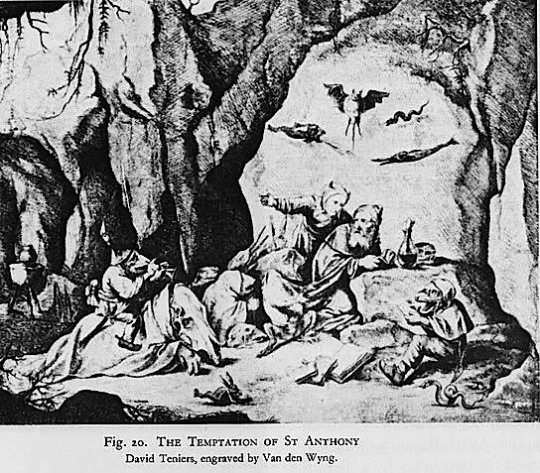

The temptation of St. Anthony was for a long time a favorite subject for artists, who could let their imaginations run riot in depicting the myriad demonic manifestations that appeared to the ascetic, tempting and tormenting him. It looks like some of those flying beasties ended up filling the air in Marc's sketch.
But a demonic assault on a desert saint is not exactly the same thing as ghostly manifestations at a séance, and as we shall see, the Imagineers eventually settled for reproducing the sort of thing you might really find in a good 19th century séance or "spirit theater" magic show. In other words, they decided to go for a REAL fake séance and not a FAKE fake séance.
You will also notice in that last Davis sketch exactly three musical instruments floating around: a bell, a horn, and a tambourine. Those are exactly the three that ended up in the finished attraction in the inner circle around the Leota table, as opposed to the other instruments and furniture floating around the outside circle, on the other side of your doombuggy.

In fact, there's yet another Davis sketch of the séance, seldom seen, that has nothing at all floating overhead except for those three instruments.
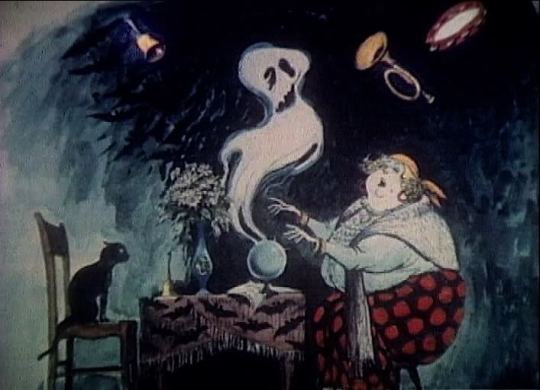
The choice of those three may well have come from another source, not de Givry but something closer to "real" ghost shows, as we shall see.
Originally Posted: Saturday, August 7, 2010
Original Link: [x]
4 notes
·
View notes
Text
The Man Who Saved the Gryphons
Do you know this man?
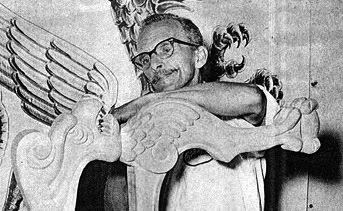
His name is Ciro Rolando Santana y Arrite, a Cuban-born sculptor who started working at WED (= WDI) in 1969. His heart-warming tale (no really, it is) was briefly told in the Fall 1969 issue of Disney News. Many Haunted Mansion fans are familiar with the article, since it provided some of the first preview photos of the interior of the soon-to-be-opened HM. (This miserly "sneak preview" consisted of exactly four, teensy-teensy black-and-whites! Jerks. Yep, still bitter after all these years.) Anyway, Rolando was hired early in '69 and was put to work carving furnishings for the HM. So Rolando is one of the many artisans who contributed their talents to the beloved attraction.
It's possible to flesh out this brief story a little, I think. There's a set of circumstantial evidence that suggests that Rolando was critically important specifically with regard to a widely-admired feature in the ride: the pair of gryphons at the foot of the "stairway" you ascend after boarding your doombuggy. Daveland has a particularly good photo of one of these creatures:
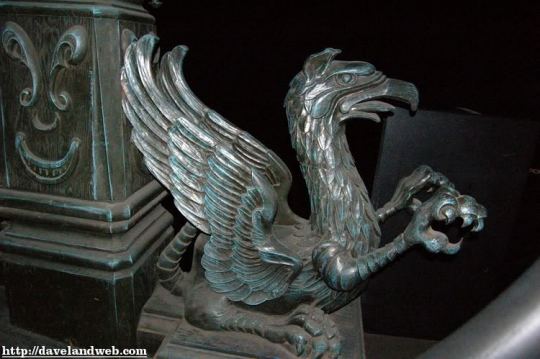
Ah yes...what could be fitter than passing between this impressive pair of impossible, flying creatures as you begin your own impossible ascent deeper into an impossible world? They are like sentinels at the gateway to the inner sanctum. And that sort of thing.
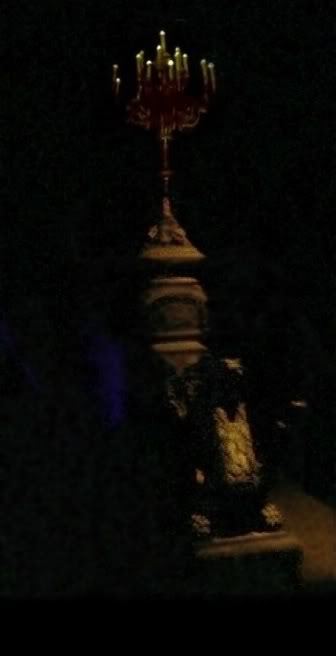

The show figures themselves are fiberglass, but obviously the original wooden sculptures was not something knocked out in a day or two. This is fine work that took a lot of time for someone.
A lot of time, but in the Spring of 1969, time was one thing the Imagineers did NOT have in abundance when it came to sculpting interior furnishings for the HM. They were getting behind in this area. WED had essentially put out a Help Wanted for sculptors when Rolando came along, and he was hired immediately. It's possible that the gryphons had been scratched—no doubt reluctantly—due to lack of manpower, and that they were restored again once Rolando was taken aboard. An Effects blueprint drawn up near the beginning of 1969 and used until the first part of April shows no gryphons at the foot of the stairs:

But the immediate successor to this blueprint, drawn up on April 8, has the gryphons in place:

In view of the timing of the sculptor shortage and the hiring of Rolando Santana, it is reasonable to suppose that the addition (or more likely restoration) of the gryphons was made possible by his addition to the WED staff. But is there any evidence that Rolando was the actual sculptor responsible for producing these pieces? There is, although the evidence is indirect. In the Disney News photo of Rolando, he is shown working on one of the two chairs at the ends of the table in the ballroom, the chairs occupied by the Birthday Girl and Great Caesar's Ghost:

Those are certainly gryphon-like creatures. If we examine some of the other carving on the chairs, we find more gryphon-like creatures:


It's a pity that these attractive details are impossible for the ordinary rider to see, but I guess that's why we need geeky blogs, eh? Anyway, to judge by those chairs, Rolando certainly seemed to have a way with carving gryphons. He may also be responsible for still another set of ballroom gryphons: the wooden corbels that decorate the capitals of the two poles which anchor the wrought iron railing up on the doombuggy balcony—one at each end of the balcony. They've been right there in front of your nose all this time, and I'll bet you've never noticed them.


pic by ww12345. That's the hall tree at the end of the balcony just as you turn to go into the attic. The drawing is based on a blueprint.
Whoever was responsible for the photos in the Disney News article evidently thought Rolando had some sort of direct connection with the stairway gryphons. It is not explicitly stated, but it is certainly implied that the "sneak preview" pics feature his handiwork. Two of the four mini-pics feature one of the gryphons and one of the newel posts they lean against, while a full-size sketch of a gryphon adorns the wall behind him.

The article was written in the Summer of 1969, mere months after Santana had come on board. Put it all together and it seems very likely that our stairway sentinels were done by Ciro Rolando Santana y Arrite. It's not just that he did them rather than someone else, it's that they probably would not have been done at all without him. If you are among their admirers, the next time you pass between them, a mental hat-tip or a murmured thank you might not be out of place.
Originally Posted: Wednesday, August 4, 2010
Original Link: [x]
5 notes
·
View notes
Text
Ravens and One-Eyed Cats, Oh My!
The unseen Ghost Host acts as a sort of ambassador, a go-between, someone equally able to speak to us in the mortal realm as well as to his fellow spirits (presumably). Other than a few directives from the Cast Member Butlers and Maids, telling us to get to the center of the stretching gallery, the GH is our only narrator and guide. He never really tells us what his motivation is in taking us on this little tour. Right up until the end of the ride, you don't know if he's good or evil.
We're so used to this arrangement by now that we forget that doing it this way was a choice. As it turns out, it was a choice made only a few months before the Haunted Mansion opened. Some of the rejected alternatives would have made for a very different ride experience if they had been implemented. One of these is fairly well known and has left traces behind in the ride. There is another one, far less well-known, which has left nothing behind. One thing they have in common is that both of them add an additional character who interacts with both the Ghost Host and with you, the rider.
Very different chemistry. This was not a trivial decision, as we'll see.
The Raven
Died in the wool Mansionites know a lot about this character, so if you're one of those, and you're impatient, you might scroll down to the Cat section, which includes stuff you've never seen, I promise.
Riders can hardly help noticing that there is a raven which accompanies them throughout the ride, starting with the Conservatory scene and ending at the entrance to the crypt at the end of the graveyard scene. There are five all together, but they are all supposed to be the same character. All it does is caw at us. Especially at DL, particular attention is drawn to it as we descend into the graveyard. Despite having our focus obviously directed at it at that point, we're gettin' bird noises and that's it.

Originally, the WDW raven sat on the branch right above you too, as you tilted back, but due to "guest abuse" it was moved back and put on a branch well off to the side. Ketchup packets, I imagine.
Caw-caw. At least the bird sounds real. According to Stacia Martin (The Sounds of Disneyland [Disney, 2005] 31), he was voiced by "Candy" Candido, best known as the go-to guy for basso profundo in cases where even Thurl Ravenscroft couldn't get low enough. (Candy must have had freakin' bridge cables for vocal cords.) What is less well-known is that Candy was extraordinarily versatile and could do very high voices as well. The same source says that Candy did the raven in Sleeping Beauty and simply hauled out his raven cry again ten years later for the Mansion.
Be that as it may, originally there were going to be several more ravens, including one in the stretching room and one in the foyer. (You can read about the latter one HERE). This was still going to be the case going into the spring of 1969. The raven was going to talk to you, along with the unseen Ghost Host. The 1968 show script which provided the basis for the "Story and Song from the Haunted Mansion" album preserves a lot of the raven's dialogue. The bird criticizes the stretchroom advice given by the GH ("He chose the coward's way! Caw-caw"). I guess the GH is a little miffed, because shortly afterwards he responds by warning you that the raven is a possessed creature, and its "restless spirit" may be looking for an opportunity to "better itself." This bickering leaves you wondering which (if either) of these voices from regions beyond should be trusted. But the raven is also the one who warns you about the ghostly hitchhikers at the end, so by that point you have probably come to trust the little guy. He even calls you "my friends," so you see? He cares. I guess there was no caws for concern. (Oh shut up; it's my blog.)
The eerie raven first appears in a Ken Anderson concept sketch. Marc Davis liked it and kept it, and it seems that there was never a time when it wasn't going to be part of the show.

Is the talking raven taken from the famous Edgar Allan Poe poem? If we're speaking of an indirect influence, the answer is an easy yes. Poe is indeed responsible for adding the raven to the short list of recognized Halloween critters (bats, spiders, black cats, owls). But even in a direct sense, the answer is yes. In an early script, the raven warns us about itself (huh?) and the hitchhikers, with "nevermore's" and "evermore's" sprinkled everywhere. The lines were recorded at one point by the incomparable Eleanor Audley (Lady Tremaine, Maleficent, Madame Leota). Warning! If you're an admirer of Ms. Audley's work (yes, yes, I see those hands), this excerpt is painful to listen to. But we historians cannot afford the luxury of pity.
Beware of Eleanor's Raven, Forevermore
[Audio Link]
Oh geesh, that was bad. Anyway, it proves that X. Atencio was directly influenced by "The Raven" when he tried to script the character. One problem with the raven—besides being annoying—was that it was too small to command your attention in some of the larger scenes. Maybe a bigger animal would work. Let's see...no, you can't have an elephant in a haunted house. How about a black cat? More specifically, how about an Edgar Allan Poe-inspired black cat?
The One-Eyed Black Cat
"The Black Cat" is one of Poe's better known tales, often anthologized, and read in many a high school English class. If you've forgotten how it goes, here's a severely abbreviated summary:
The narrator had a beloved black cat for a pet, but one day in a fit of alcoholic rage he gouges out its eye with a knife. Later on, guilt at the sight of the one-eyed black cat turns to resentment and he kills the animal. Later he finds (or is found by) another one-eyed black cat and takes it as a pet. In yet another one of his fits of rage he murders his wife and walls her up in the cellar. When the police investigate, however, the narrator is betrayed by the howling of the cat inside the wall, where it had been walled up with the corpse.
A much creepier Poe animal than the raven, certainly. Most Mansion fans know about the existence of the one-eyed black cat only from a couple of Paul Frees outtakes, in which he tries out his note-perfect Bela Legosi and Peter Lorre voices while using a revised HM script. Dude, when Count Dracula sees fit to warn you about a kitty, it must be one bad motorscooter.
Ghost Host Bela warns you about a nasty cat
[Audio Link]
Ghost Host Peter warns you about it too
[Audio Link]
As you can gather from those, X's cat was much scarier and more demonic than his raven. None of the cat's dialogue has survived, but X did a series of concept sketches. The notion that the cat would be co-narrator may even predate the notion of putting the earlier raven character into that specific role. It looks as if the black cat might first manifest itself at first as nothing more than an eye:
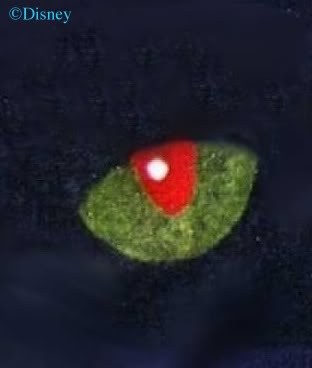
Apparently, the eye would morph into a shiny point of laser-like light, and a cat face would appear with only one eye. The first eye you saw turns out to be the missing one. From the looks of it, this loud and angry feline is looking for more than just a Little Friskies num-num.

The morphing continues, and the face rots into a more human form. Not surprisingly, this does nothing to improve its mood.
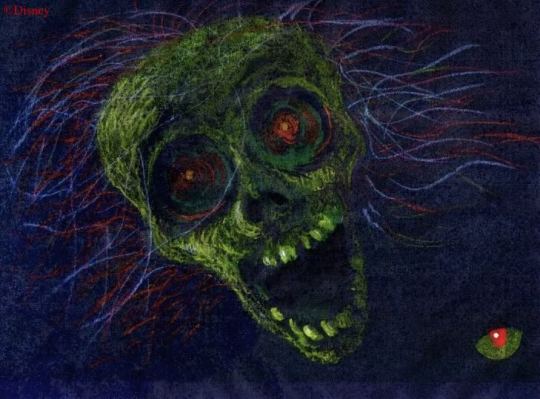
Good Lord. And how was this thing going to be presented? A projection? That isn't clear. It's possible that the "cat" was going to just pop out unexpectedly along the way in its various stages of demonic materialization. The face above looks a lot like a blast-up head in another X concept sketch. A quick look at some actual blast-up heads (inset) confirms that this is what the artwork is about.

So maybe our creepy "cat" was going to jump out and surprise us here and there throughout the ride. Good Lord.
When neither the demonic one-eyed black cat nor the "nevermore"-squawking raven ended up being used, the HM lost its only clear Edgar Allan Poe allusions (although you could make a case for a Tell-Tale Heart allusion in the bride's beating heart). It would have been nice if someone had told the composer of this WDW pre-opening publicity poster that the Haunted Mansion could no longer be accurately described as "Edgar Allan Poe-styled."

The black cat was a short-lived idea, with good reason. By having the Ghost Host warn you about a clearly malicious and dangerous creature like this one, he cast himself into the role of protector. He was there to help you. Similarly, in the 1968 script, the GH graciously informs you at the outset that you will not be harmed. That's very decent of him.
Too decent. Who wants Santa Claus for a Ghost Host? A haunted house is an allegory of life itself. You enter here and you exit there, and in between is a dark twisted corridor filled with frightening sights. You may get advice along the way, but you never have quite enough evidence to be sure that those voices have your best interest at heart. Do you really want to go into that haunted house that the neighbor kid put up in his garage for Halloween—the one who's a minor league juvenile delinquent the rest of the year?
Enter if you dare.
The Haunted Mansion is no different than any thirteen-year-old's spook house, and it's no different from life. Once you're in, you don't know if the Host is benign or malicious, so you have no choice but to go ahead, even with insufficient data. When you're stuck in a haunted house, the secret is to not panic and to keep your wits about you and to just keep going. If you do that, you're likely to make it.
Kinda like life.
So the trouble with the villainous black cat is that it made the Ghost Host much too unambiguously a good guy. It's important that he make you a little nervous, a little unsure.
What was the trouble with the raven, then, aside from being a tad too small? With the cat, we had a bad guy co-narrator and a good guy main narrator. With the talking raven, we had a morally ambiguous co-narrator along with a morally ambiguous Ghost Host. At first, you don't really know if either of them can be trusted. But in that case, why do you need two narrators? The real problem with the raven was that it was redundant. Turn off its dialogue and give its few substantive comments to the GH, and ta da, nothing is changed. Just make sure the GH never really tells you what he's up to.
.
Originally Posted: Wednesday, July 28, 2010
Original Link: [x]
7 notes
·
View notes
Text
Mansions Known and Unknown
[New artwork added Nov 1, 2012. Major additions were added (as additions are wont to do) Jan 28 and June 2, 2014, in pink. Yet a further addition arrived in May 2017, in red.]
Who doesn't want to draw a haunted house, especially if you're a good artist and you can? Perhaps half a dozen different artists took a whack at conceptualizing the Disneyland haunted house between 1951 and 1961. That may or may not be a record, but it's really not surprising. As many of you know, even in his earliest ruminations Walt wanted to include a haunted house in any future amusement park he might produce. This was back when "Disneyland" as we know it was not so much as a twinkle in his eye.
Some of these images are well known, some less so, and some not well known at all. I thought it would be a nifty idea to gather all of them together into a single location, which I don't think anyone has done before.
It all starts with Harper Goff's 1951 sketch. I'd classify this one as "pretty well known." There's no attempt here to figure out how the thing would actually work as an attraction. This is just concept work.
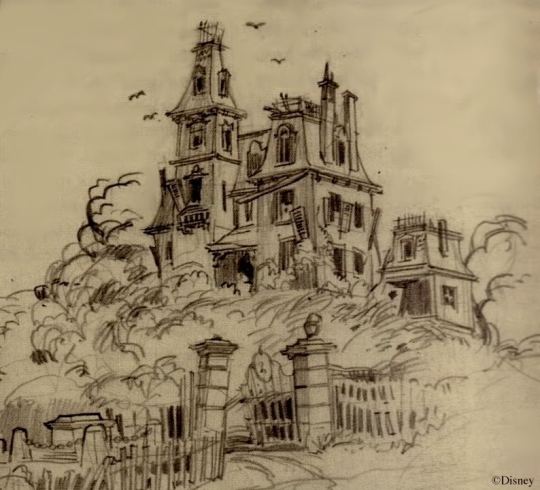
At first the haunted house was going to be on Main Street, an "old-dark-house-at-the-end-of-the-street" kind of thing. This 1953 sketch by Dale Henessy is not as well known as Goff's.
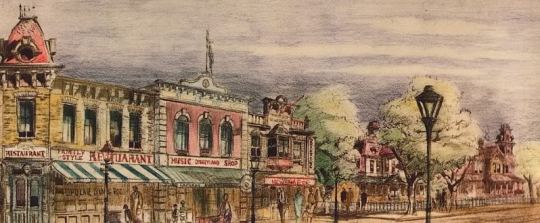
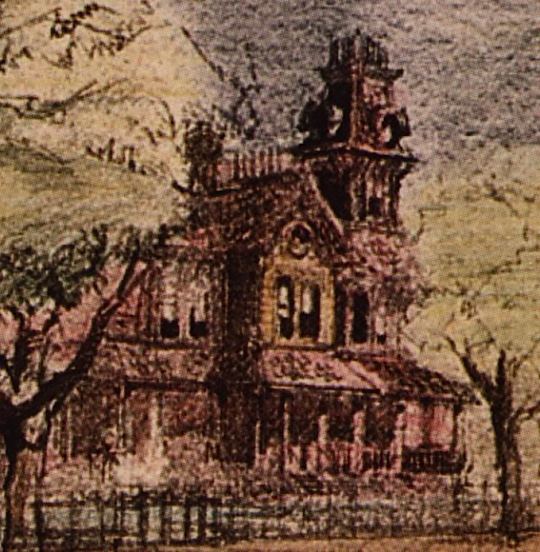
It's because of this Henessey sketch that I am now convinced that Herb Ryman,under the personal direction of Walt, put a haunted house in this famous sketch:

Many of you know the story. One of the potential financial backers for the Disneyland project (ABC network) wanted to see something concrete before committing themselves, so Walt and Herb did this sketch in a hurry-up marathon session over a weekend in 1953, and it did the trick. Anyway, reader refurbmike pointed out in a comment that it may well contain a haunted house, and sure enough, in exactly the same spot as in Henessey's sketch, you find this:


Since Ryman's sketch actually precedes Henessey's, we can be pretty confident that this doesindeed represent a haunted house, since Henessey evidently interpreted it that way.
And...here's something new as of May 2017. This is from a copy of the above sketch that Herb Ryman himself supposedly reworked further by tinting it and thickening some lines, in order to achieve greater clarity and emphasis. It sold at auction in 2017 for more than $700,000. Here's the Haunted House part (courtesy of Jeff Baham).
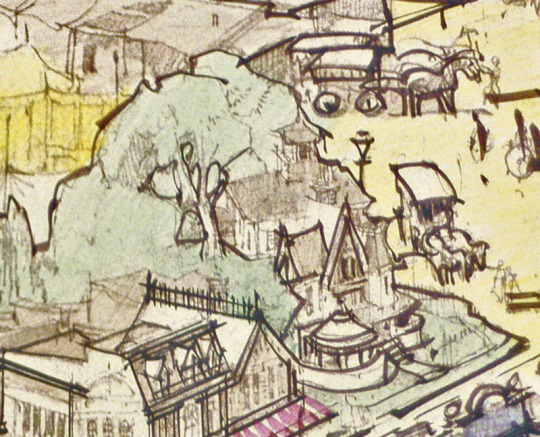
Moving on, at least one artwork in this discussion can be debunked. The following drawing by Roy Rulin has been identified in a Disney publication as a concept sketch for a Disneyland haunted house. In reality, it's a concept sketch for a 1956 Hardy Boys television episode, "The Mystery of the Applegate Treasure." Compare the photo below from the show's opening sequence. (Special thanks to readers Chris Merritt and Jeremy Fulton for clearing up the old mystery. A couple of modern-day Hardy Boys, I guess.)


The first artist to come up with a design with serious legs (although that sounds like something Rolly Crump would do) was Sam McKim, about 1957. Not only did he sketch a haunted house, he did preliminary architectural design on it as an attraction, and he was confident enough about it to put it on one of his classic, cartoon-y, souvenir park maps, as if it was a done deal. We're not on Main Street any more. This one is in the back corner of the proposed New Orleans Square, almost in Adventureland. In fact, it's right about where the Indy Jones ride is today.



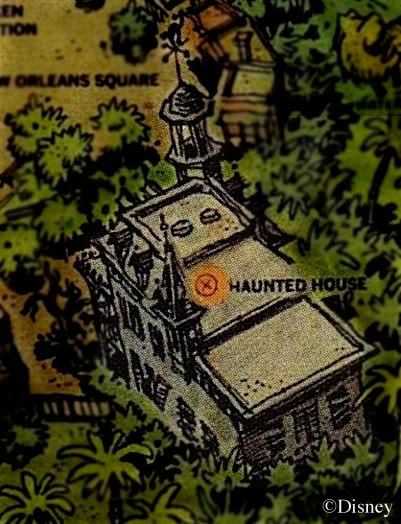
In May of 2014 a very rough early sketch was published for the first time:
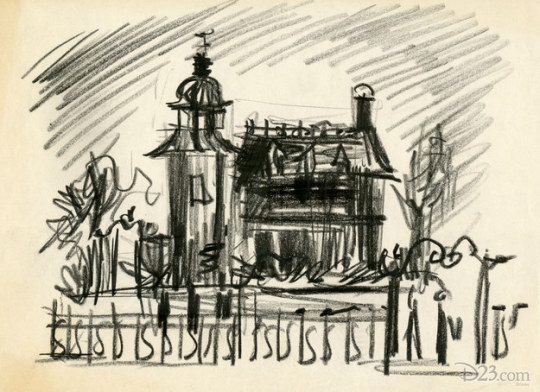
Joe "Datameister" Cardello, a future Disney Imagineer, has taken a special interest in this disused Sam McKim design and produced a highly-ambitious and very impressive three-dimensional computer-graphic recreation. You can see the whole set of images HERE.

That takes us to 1957, but in 1957 Ken Anderson was given the haunted house assignment, and the next chapter is very well known indeed. Ken did a sketch based closely on the Shipley-Lydecker house in Baltimore, and it proved to be the defining look of the building to come.

Two or three artists used Ken's sketch as a springboard for further work, narrowing down the architectural details and conceptualizing the landscape setting. Most famously, of course, Sam McKim did a paint-over of Anderson's sketch, producing what is perhaps THE most iconic rendering of the HM of all time. The whole painting seems to swirl with movement. Yeah, I know I've posted this before, but I never tire of looking at it.

I suppose McKim could take some solace in that fact that at least Ken kept his black cat weather vane. This Anderson sketch dates from September 17, 1957. The painting may be his as well. They show the kind of setting Ken explicitly had in mind.


With this 1961 sketch (actually, a "working elevation" drawing) by Marvin Davis we are getting close to the finished version, but it still retains a number of features from the Anderson version that will be altered within the coming year. For example, we still have the square Shipley-Lydecker cupola, and we still have McKim's black cat up on top, soon to be replaced with a schooner (sorry, Sam). We finally have the neat and clean look that Walt demanded, anyway.

In fact, if you compare the Marvin Davis drawing to blueprints of what is actually there, you will notice quite a number of substantial differences, so in my view we are still en route from Ken's first sketch to the final building, although obviously we are getting close.
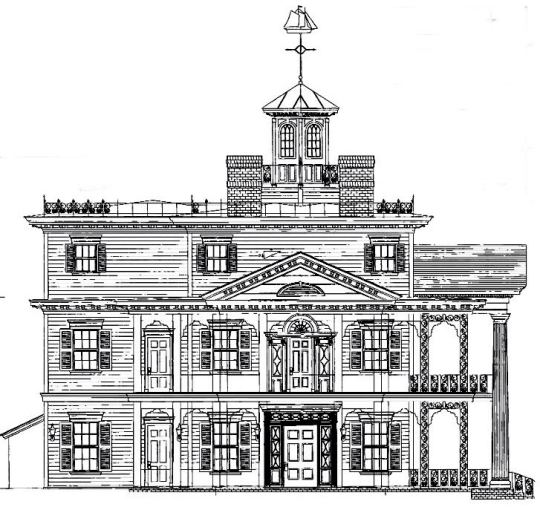
A similar story about the architectural development of the WDW Mansion could be told too, but naturally it wouldn't have the depth of history or the sheer variety of artistic concepts that the original DL version had.

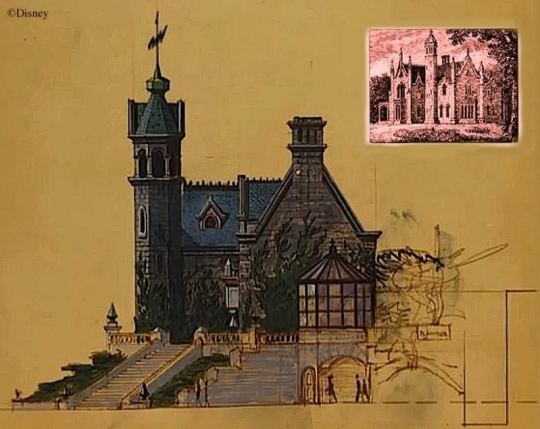
One alternate worth mentioning is Disney legend Herb Ryman's concept of the WDW HM as an ordinary looking, pre-revolutionary, New England manor house. It's handsome, yes, but . . . a little dull.

(Major revisions to this post in light of subsequent comments are highlighted in orange.)
Due to the nature of tumblr posts, I have not been able to change the color of the text. The highlighted areas have been bolded.
Originally Posted: Wednesday, July 21, 2010
Original Link: [x]
7 notes
·
View notes
Text
The Pet Cemeteries
Yes, there are two. Imagineer Kim Irvine (daughter of "Madame Leota" Leota Toombs) came up with the idea for the first one in the early 1980's. Not a lot of time and effort went into the project. Kim just purchased off-the-shelf yard statues of a dog, cat, skunk, and frog (complete with mouth hole for squirting water) and had Imagineer Chris Goosman compose some macabre epitaphs for the pedestals. They were put in the vacant yard on the north side of the HM, alongside the wheelchair access path, reportedly to give them something to look at over there.

(pic by Monstersgoboo)

BIG JAKE
Here lies my good dog Jake.
Chasing a toad down a well was his one mistake.
In memoriam MISS KITTY
After losing eight lives you still had no fear.
You caught a snake in your ninth and that's why you're here.
R.I.P. BULLY
You didn't drink, you didn't smoke.
I just can't figure what made you croak.
In loving memory of our pet STRIPEY
You may be departed,
But your presence will always linger on.
Everyone seemed to like this little HM secret, so in 1993 they put another one in the front yard.
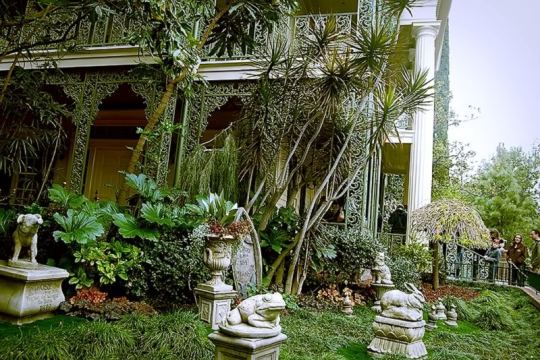

It has proven so popular that they subsequently added similar pet cemeteries to the WDW and Tokyo HMs.
And so on.
Those are the well-known facts, familiar to most Mansionites, if not to the general public. Beyond that basic history, no one has bothered to say much. But Long-Forgotten readers are a tough and discriminating audience. They ask, nay, demand more. Pry up those rocks and see what's crawling around underneath.
A new addition came to the original pet cemetery in the summer of 2016. They needed to add another exhaust vent for the train tunnel going behind the HM and decided to make a virtue of necessity by disguising the vent as a crypt. So far so good, but the crypt is in the pet cemetery, and they made it up as a goofy, elephant grave. The crypt itself is tolerable, falling within the wide embrace of Victorian eccentricity (which, after all, gave us elephant foot umbrella stands), but that trunk looks absolutely awful. How can anyone over the age of eight, let alone Disney Imagineering, look at the exterior and landscaping of the Anaheim HM and conclude that it is an appropriate venue for this sort of zany kookiness? Barf. This looks like a refugee from the execrable queue in Orlando, disaffectionately known in these parts as PLQ:
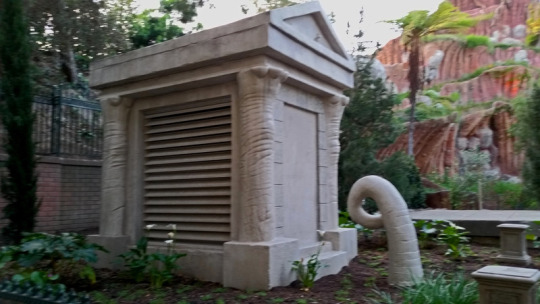
Sometime around October a plaque appeared on the front:

More cutsie-wootsie stuff, ill-suited to the dignified exterior of the HM. And I hadn't noticed the mouse in previous photos, so I'll point to it now as part of the whole package. Anyway, bleahh. I'm only glad all of this is in a place generally unseen and easily ignored. I look forward to spending a lot of time forgetting it exists.
As I said in the last post, I'm not a huge fan of the PC. I think most purists and traditionalists see it as an unwelcome intrusion of sheer fantasy before the attraction even begins and would happily see it gone. That's more or less been my position too, and yet I can't get worked up about it. Something about the pet cemetery is okay, and it's time to figure out why. Let's take a closer look.
Much of the front yard version simply repeats the formula of the old one. Once again you've got a lot of store-bought statuary sitting on pedestals with macabre epitaphs. In fact, two of the statues (the frog and the skunk) are virtually identical to their back yard counterparts, although they have new names and texts. The main difference out here is that some dates are attached. The frog is "Old Flybait" ("He croaked, August 9 1869") and the skunk is "Beloved Lilac" ("Long on curiosity...Short on common scents, 1847"). There's also "Rosie" ("She was a poor little pig, but she bought the farm, 1849") and a dog named "Buddy" ("Our friend until the end"). The latter may be a long-overdue tribute to Buddy Baker, the musical genius behind the HM score. The dating formula is obvious in the case of Old Flybait; it's exactly 100 years before the HM opening day, and this suggests that the other dates are really cryptic references to 1947 and 1949, probably the birth years of the Imagineers involved.
There's nothing terribly out of place in any of these examples. They are all of a piece. We can easily imagine one or several family members in the mansion's long history being animal lovers and burying their pets out front, complete with whimsical epitaphs. Even if the choice of animals is eccentric in some cases, there is nothing surreal involved, not even anything supernatural.
In one case, however, these conventional statues are arranged in such a way as to suggest that the animals involved have business to conduct in the afterlife.
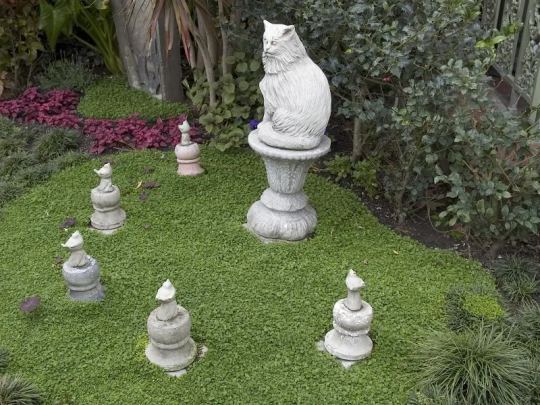
There is a clever thematic continuity between this cluster and some of the relationships you encounter inside the house. Imagine the graveyard executioner, a man who in life wielded the power of death but who has now followed his victims into the grave. It's called irony. Better still, imagine the cat as Constance and the birds as her husbands, and you can feel the same chemistry at work. No one forms a partnership with Death so powerful and so lasting as to avoid the same fate as Death's other victims. It's a classic statement, made at least three times in the attraction, starting with this tableau. I think the cat-and-bird set is perhaps the high water mark of the pet cemeteries.
There is, however, a whole other set of grave markers. These are original WDI designs, and they have a more fantastical flavor. I suspect that it is these that rub some fans the wrong way. There's Fi Fi the dog, with her cruciform tombstone made of crossed bones and her portrait with crossed-X eyes (like in the funnies). This piece is significant for reasons that have nothing to do with the intentions of the designers. It represents a change in the general culture between 1969 and 1993, but that will be the topic of another post. For the moment, I'll simply note that it is the only cross-shaped headstone in the entire attraction, including all of the scale models and all of Marc Davis's concept art.
The other weird monuments are for a snake, a bat, a rat, a fish, and a spider. The pieces are nothing if not stylish.
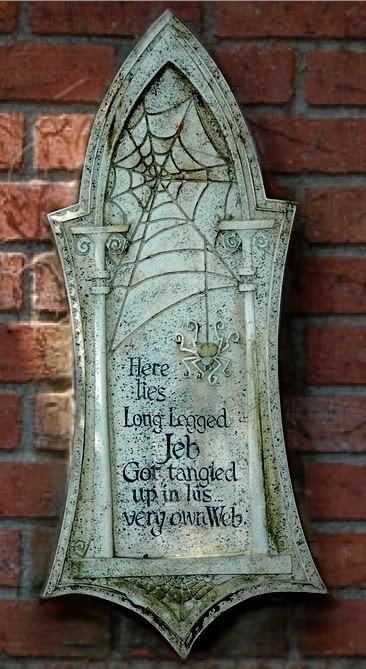


It's a good deal harder to imagine these as simply the products of animal lovers in the Mansion's history. The style of the monuments themselves is too bizarre. Perhaps we are to imagine not merely animal lovers, but insane animal lovers, if we want to keep these within the imaginative realm of a real house with a history of real occupants—which is the starting point of the HM voyage. If imagining these pet monuments as items designed by crazy family members seems a stretch, then these freaky-deaky things simply don't belong here. For me, there are enough tales of nutball Victorians to keep it all just barely within bounds.
As if to illustrate exactly that point, Craig Conley sent me in November of 2016 the following clipping from a 1913 edition of Popular Mechanics,noting an 1855 grave marker for a fish.
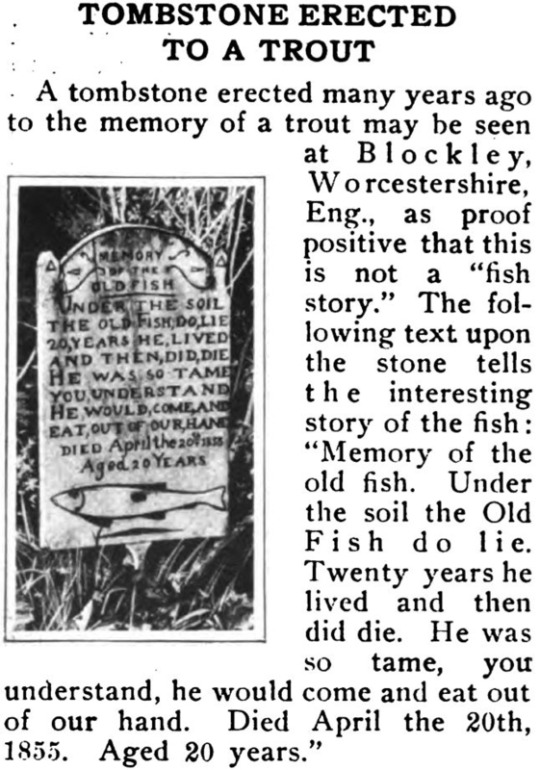
Okay, even if we are not necessarily in the realm of fantasy, you still wonder what the original Imagineers were shooting for. In one of the Long-Forgotten threads at Micechat, someone argued that pieces like Freddie the Bat were inspired by Tim Burton's Nightmare Before Christmas, which would eventually take over the whole Mansion every Fall and Winter, of course. If you compare concept art for Freddie with typical NBC artwork, the similar look and feel is indeed striking.


But the dating is against it. NBC was released the same year the pet cemetery was installed: 1993. Better to look elsewhere for inspiration for this fantastic and surreal streak. [Edit: But see new evidence below.] As a matter of fact, the original HM Imagineers did kick around some lunatic pet ideas for the HM. Ken Anderson toyed with having a man-eating octopus in a pit in the middle of a room in his 1957 Ghost House. Which is pretty . . . out there.

Then there's this delightful but unused Marc Davis gag:

But if we're looking for justification for adding an element of the strange and fantastic to the Haunted Mansion, the obvious place to look is in Rolly Crump's unused "Museum of the Weird" designs. Do I detect a whiff of the Museum in the pet cemetery? (Or *sniff* is that just a dead fish?)

Very, very few people know this, but Rolly actually designed some bizarre tombstones for the HM. Where they would have been used, I can't imagine, but it must be admitted that Freddie the Bat has nothing on Velma Wingspan when it comes to eccentricity, and isn't the spidery lettering style used on the pet cemetery stones just a teeny weeny bit reminiscent of Rolly's "Museum" font?
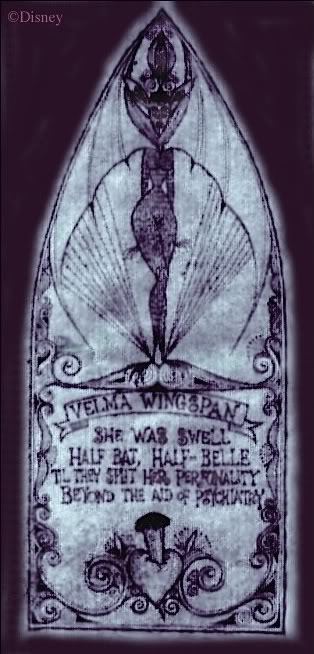
"But even if Ken, Marc, and Rolly kicked these kinds of ideas around, they ultimately decided NOT to go in that direction, so even if the pet cemetery Imagineers were drawing inspiration from those guys, they also overrode their judgment by going ahead with this kind of thing."
Yeah, I hear that, and it's a good point, but I still take some comfort in the idea that the newer Imagineers respected and revered the original masters and sought to draw inspiration from their work. And anyway, since the pet cemetery, even at its most surreal, can be placed within the imaginative orbit of the Mansion, I've decided to call a truce on this one.
New Evidence for Tim Burton's Influence
One of our "Anonymous" commenters directs our attention to a short 1984 film by Tim Burton, Frankenweenie, produced by Walt Disney pictures. Reportedly, Disney fired Burton after making it, claiming he had wasted company resources and had produced a film too dark for Disney to use. It later had video and DVD releases.
Well, SOMEONE at Disney liked the film. There can be little doubt that it was a direct influence on the front yard pet cemetery. The film is a parody/homage to Frankenstein, so there are important graveyard scenes—in a pet graveyard. It appears also in the film's opening titles.

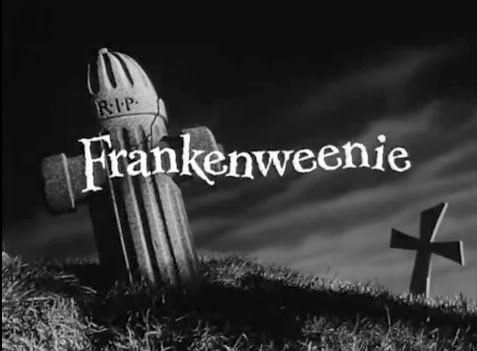

Fifi's tombstone at Disneyland is obviously taken almost directly from this movie.
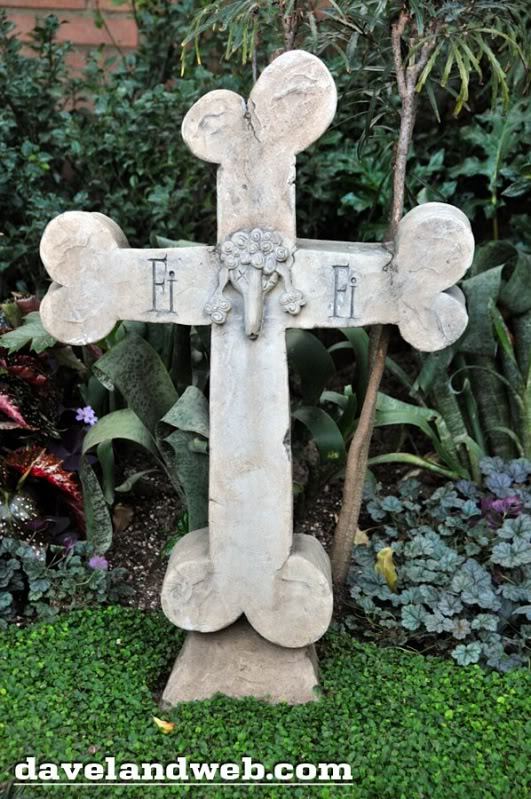
There are several bone-cruciform tombstones in the Frankenweenie cemetery, but "Sparky" is the main animal character in the film.

Even the shape of Fifi's head and the "X's" for her eyes may havebeen inspired by various other tombstones seen in the film.

Then there's "Earl."
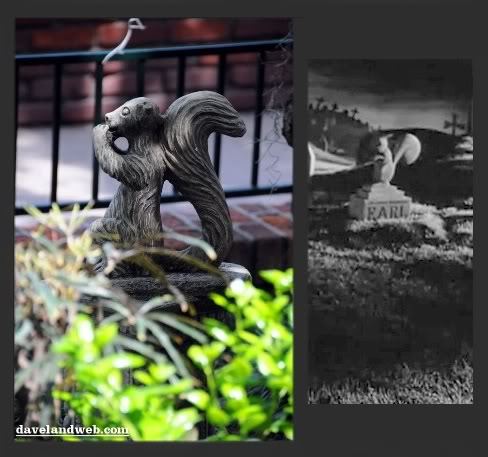
There are also tombstones for a goldfish and a snake in the Burton graveyard.
This raises the distinct possibility that Imagineers (or at least Kim Irvine) were aware of Burton's work on Nightmare while it was in production and saw some of the models, and so possibly that artwork was an additional influence on the style of the 1993 HM pet cemetery.
A big thanks goes to "Anonymous" for the tip.
Originally Posted: Monday, July 19, 2010
Original Link: [x]
6 notes
·
View notes
Text
That’s My Queue
The back half of the queue area for the Disneyland Haunted Mansion has a long and curious history. Major additions to the berm took place in September of 2016...

...but the queueing area down below remained the same, still looking much as it does in these older photos:
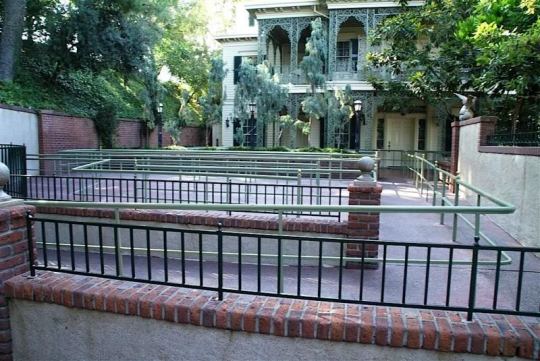

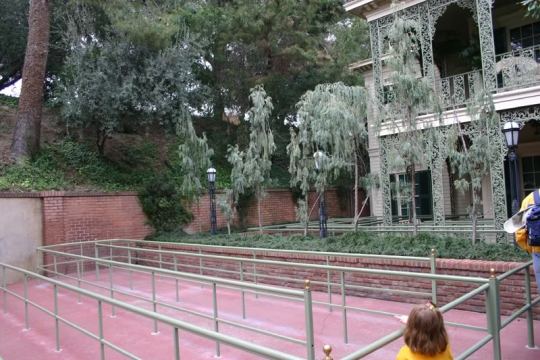
"That's my favorite brass knob. That one, right there."

That last one from Daveland has some magic in it, so stay tuned. (A big tip o' the hat to Dave.)
I'm old enough to remember this section when it hosted the family plot graveyard, a short-lived minor masterpiece remembered today by few. Back in the opening year, when a much higher percentage of riders had no idea what lay in store for them, the queue graveyard was virtually the only clue you had as to the tone of the attraction. Plus, the lines were longer and slower back then, so you had plenty of time to contemplate the epitaphs (and if you were a geek, to memorize them). If you're a Mansion fan, you really ought to know about this long-forgotten gem.
In the original version of this post (which has been rewritten umpteen times as new material has come to light), I was content at this point to simply remark that there aren't many photographs of the little cemetery, and I threw this meager montage at you before continuing:
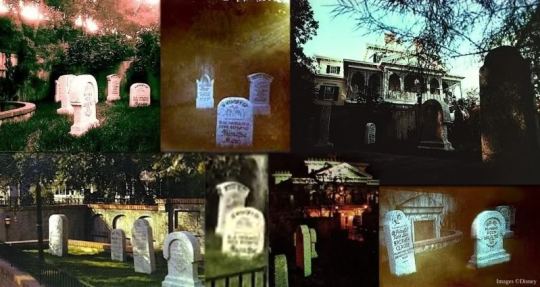
I also mentioned that you could get a glimpse of the old graveyard in the 1970 Osmonds Disneyland Showtime episode, which featured the HM.

But in August of 2016 Gregg Ziak published these spectacular photos of the original graveyard at the "Vintage Disneyland" page on Facebook:

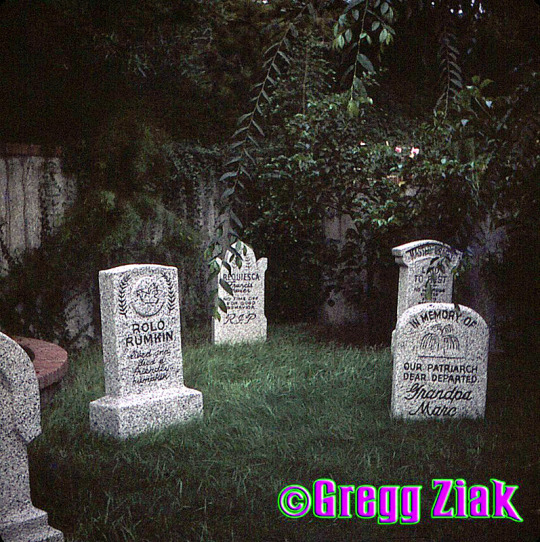
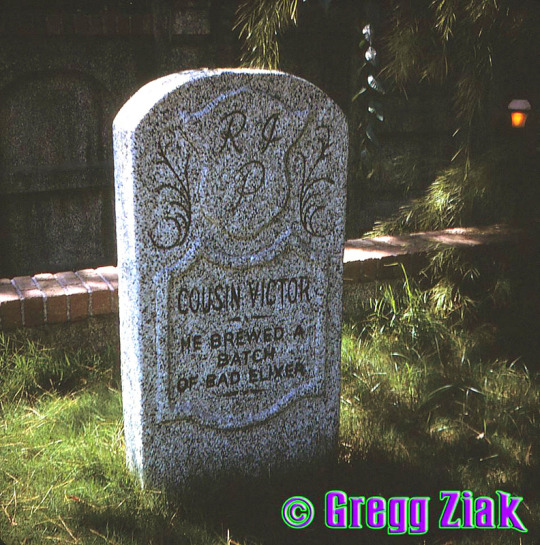
So I figure I'd put up some of the better photos I've got rather than that ugly little montage. I'm not at liberty to show you every photo I've got, but these are among the best. This first is actually a bw photo by Athenamama that I've colorized and processed in various ways. Turned out nice.

You know this one.
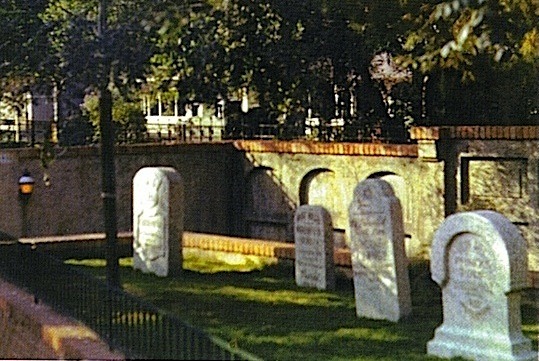
"It's the backside of Wathel!" (Some of you will get that; some won't. Some who do will wish they hadn't.)
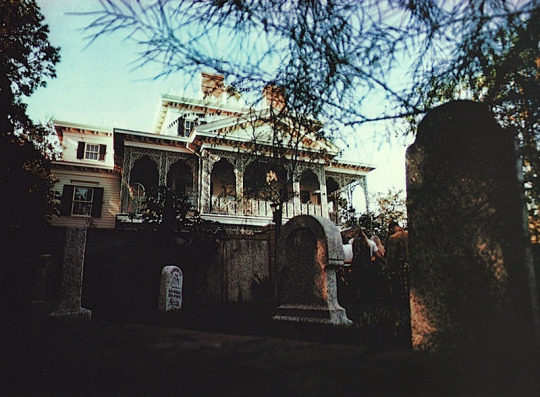
As it happens, one of the extant photos of the family plot was taken from exactly the same spot as the Daveland photo above. Not only that, but this 1996-98 photo by Allen Huffmann at DisneyFans...
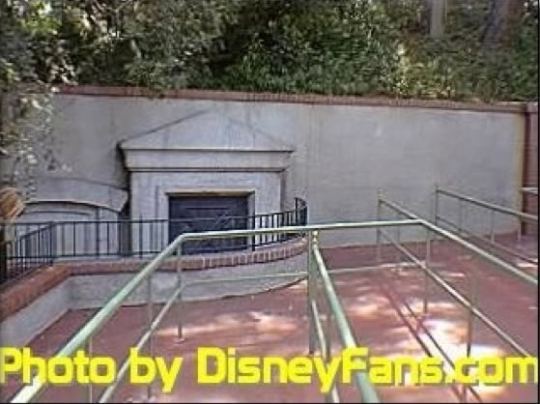
...was taken from almost the same spot as a publicity shot of the Osmonds in the old cemetery, one of several pubbies released to the papers before their March 1970 TV program...
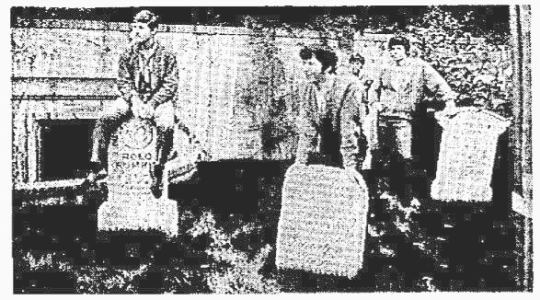
...and from that wretched photo a serviceable rendition of the boneyard sans Osmonds (and Kurt) can be made.
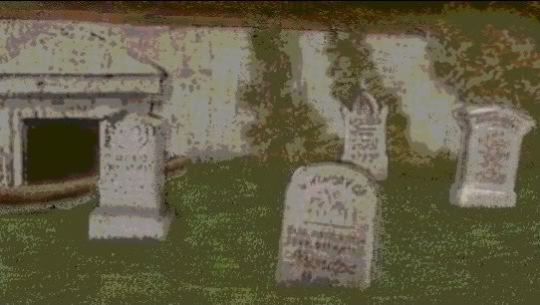
Between the two sets, a pair of cunningly-crafted animated gifs should show you exactly where the old graveyard was located. And since Long Forgotten is all about cunningly-crafted, here y'go (with our thanks to Captain Halfbeard for the gifs).


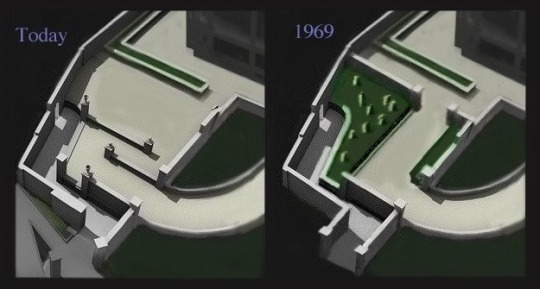
There were eight stones in the family plot, arranged like this:

I've put the best photos I currently have of each of the eight original stones side-by-side with the new, 2016
versions in the post on that topic, so there is no longer any need for a miserable montage here. Check 'em out.
Did I hear someone say they wanted "magic eye" 3D's? We got 'em, in two groovy sizes. Dude, it's like being there.
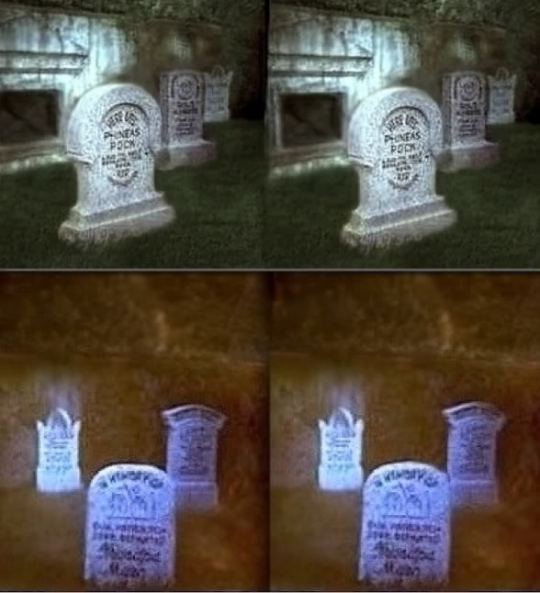
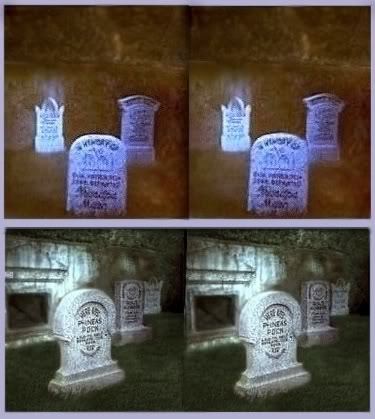
As many of you know, the epitaphs were composed by show writer X. Atencio as wry tributes to various Imagineers who worked on the Haunted Mansion. Here are the original Disneyland eight, left to right in the layout above, with the Imagineer thus honored:

The WDW set was probably created at the same time, but it is not identical to the DL set. Orlando has only five of the DL eight, leaving out Cousin Victor, Phineas Pock, and Rolo Rumkin. On the other hand, they have several others that Anaheim did not have originally:
RIP Good friend Gordon
Now you've crossed the river Jordan
Here lies a man named Martin
The lights went out on this old Spartan
Rest in peace, Cousin Huet
We all know you didn't do it
RIP In memorium [sic], Uncle Myall
Here you'll lie for quite a while
Here lies good old Fred
A great big rock fell on his head
RIP
RIP Mr. Sewell
The victim of a dirty duel
Peaceful Rest
Dear departed Brother Dave
He chased a bear into a cave
In 2002 a new animated tombstone was added at WDW:
Dear sweet Leota, beloved by all
In regions beyond now, but having a ball
The Imagineers being honored in these WDW epitaphs are listed here, if you're interested. I'm too lazy to duplicate all that info now, and we've got other ground to cover. (I do give some special attention to the Martin stone HERE, because it's often misattributed.)
You hear these epitaphs described as "witty" and even "frightfully funny," an example of Boot Hill-type gallows humor ("Here lies Lester Moore. Four slugs from a .44. No Les. No Moore."). Okay, many of them are, but let's face it: in others the whimsy is so subtle as to be practically non-existent. "In memory of our patriarch, dear departed Grandpa Marc." "Master Gracey laid to rest, no mourning please at his request." I have to stop here as my laughter becomes uncontrollable. No, really, if there's humor in there, it's so dry that even an Englishman might miss it. Don't get me wrong; I love it. It's the comedic equivalent of watching someone trying to see how slowly he can ride a bike without falling over.
The family plot was actually constructed in June of 1969, and so it was there by opening day in August, but the park quickly realized that they needed more room for crowd control, and the graveyard was doomed almost from birth. The current arrangement of back-and-forth queueing replaced the little cemetery at the beginning of May, 1970, less than nine months after the Mansion opened.
X wanted to award the stones to the Imagineers to whom they paid tribute, and so they ordered up a fresh batch of headstones for installation up on the berm. As it turns out, the only guy who took his tombstone home (as far as we know) was X himself. It's still sitting in his backyard today. Marc's sat by his desk for a time, until he finally couldn't stand having his own tombstone staring at him while he was trying to work, and he got rid of it. Rolly's stone ended up inside the ride, in the graveyard scene, not far from the singing bust that also goes by the name of Rollo Rumkin [sic]. Wathel Rogers' and Vic Greene's stones went onto the berm, along with Phineas Pock, which wasn't a tribute to anyone. The fates of "Master Gracey" and "Brother Claude" are unknown. It's possible they went up on the berm too, but according to "Anonymous" in the Comments section below, who claims to have intimate knowledge about the subsequent history of the stones, only three were recycled. Take it FWIW.
Exactly where the berm transferees were located on the hillside, we don't know, but don't worry: I'll devote a whole post to the berm graveyard one of these days.
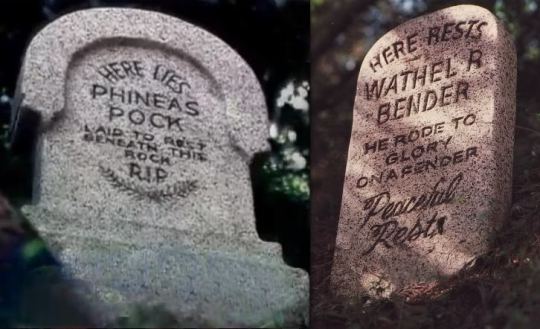
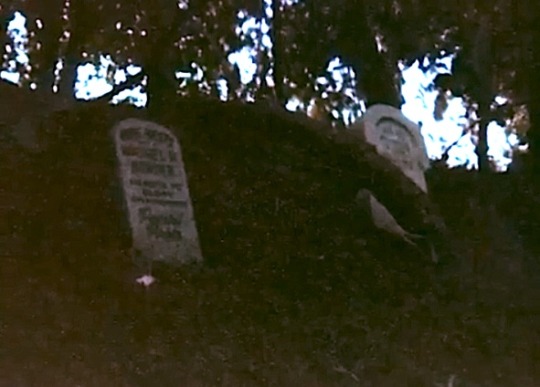
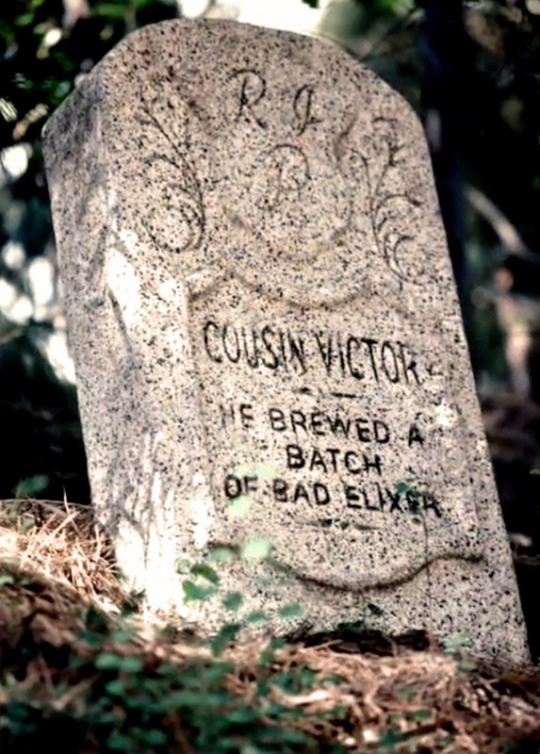
(©Disney video)
Pock Marked
"Phineas Pock" may have originally been the name they were going to give to the Ghost Host. Reportedly, there's a blueprint around of an unused WDW tombstone reading "Phineas Pock, Lord and Master." Be that as it may, they got a lot of mileage out of the name. One of the singing busts is "Phineas P. Pock." It's on the blueprints and on the leaders for the film strips they used to use for the effect, so that one is as official as it can possibly be.

The purported author of the popular old souvenir booklet, Magic from the Haunted Mansion, is a certain "Phineas J. Pock."

And then there's the "Phineas Pock" who died in 1720 and starred in a radio ad when the Mansion first opened in 1969:
Phineas Pock Radio Ad
[Audio Link]
In the spring of 2011, up popped a Phineas stone in the expanded graveyard at WDW:
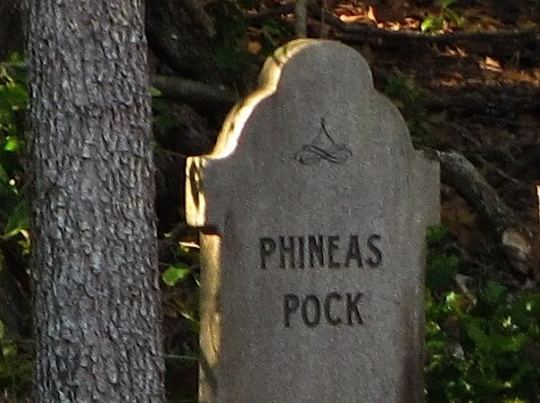
For the sake of completeness, I suppose I should mention that one of the new crypts in the WDW queue is for "Prudence Pock."
No doubt some people associate Mr. Pock with the rotund hitchhiker, who is also known as "Phineas," but that name actually originated with a cast member who probably was influenced by the plethora of Pocks already there. If you want to try to sort out this peck of Pocks, feel free. It's just a funny name.
Plots That Follow The Plots
There is a great deal of logical continuity to the mass of data presented to you with the HM. It's hard to know how much of it is deliberate, how much is dumb luck, how much is the Imagineering team's artistic instincts firing on all cylinders, and how much is the Haunted Mansion Muse, overseeing the project at all times and eliminating patent absurdities as they arise. The two human graveyards are a good example (there are two pet cemeteries too).
In your imagination, the queue graveyard—in either its ground level or its original berm incarnations—was not to be confused with the graveyard scene that provides the ride's climax. That graveyard is a very old public cemetery, next to which the Mansion was built sometime during the 19th c. It's "out back" in some vague sense, behind the berm and the trees, not visible from the front. The Caretaker is not connected with the HM but is a public employee, caring for that old municipal cemetery. That's why you go through that big iron gate to get into it, and that's why Collin Campbell put a sign on the gatepost in his painting of it.
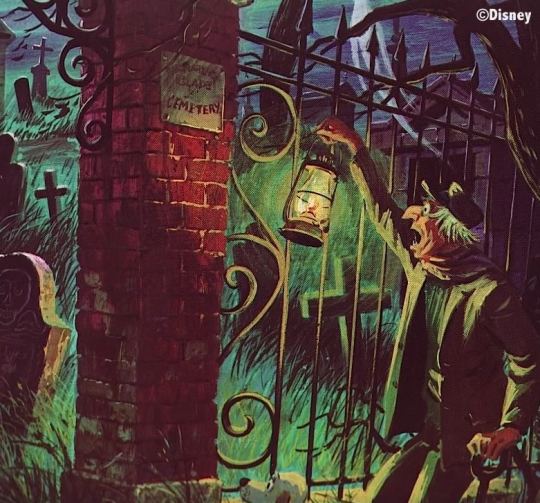
It's "something-something Glade Cemetery." Maybe "Whispering Glade"?
The headstones back there are uniformly in the style of 16th-18th century New England grave markers, and many of them are dated accordingly. They're much older than the house, in other words.
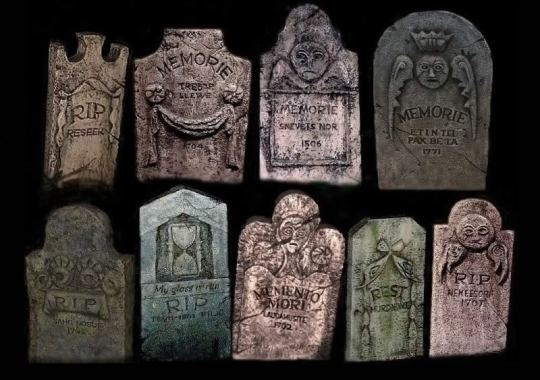
There are hidden tributes on those, too, but that's yet another blog post.
In contrast, the boneyard out front was, as I've already called it several times, the family plot, the private family burial grounds. That explains the relatively modern (i.e., 19th c.) tombstone designs, and that explains the familial terminology: "Grandpa," "Brother," "Cousin." How carefully all of this was thought out—like I say, I can't tell. But the coherence in details like this, even when it isn't strictly necessary, is one of the things that embolden me to reach for the word "art" without embarrassment. There is an unexpected imaginative unity in the whole presentation.
Whether or not the new (2016) berm graveyard follows suit is debatable. The stones are, for the first time, made to look old. They're worn and cracked. That, together with the wall-top fencing, might encourage guests to assume that the berm graveyard is simply the "back there" graveyard spilling over the hilltop and down to the wall. Be that as it may, our little tour of the short-lived, original, long-forgotten, front yard cemetery is now completed.
Originally Posted: Friday, July 16, 2010
Original Link: [x]
5 notes
·
View notes
Text
Gus, the 2000 Year Old Man
I've just about run out of decapitation jokes and puns, so let's move a head to our next destination, which is only a few feet away. This is yet another in our series of probes for the ultimate inspirations and cultural roots of the Mansion residents. This one seems like a slam dunk, or is it your imagination, hmm?

Seems like a pretty good match, doesn't it? Of course the "chain" detail is slightly different, but otherwise that sounds a lot like "Gus," as the little prisoner is known. ("Gus," "Ezra," and "Phineas" were names given to the hitchhikers by a veteran Cast Member at WDW, and they've stuck, climbing to the level of official Disney sanction.) Anyway, the description comes from an almost 2000-year-old ghost story, well-known and often cited in surveys of beliefs about ghosts and spirits throughout history. The story is in a letter by Pliny the Younger (ca. 62—113 AD). You can read it HERE. It's in a stuffy, Edwardian English translation (the only one in the public domain), so take your time, or else you can make do with this synopsis.
Pliny wants to know his friend's opinion about whether ghosts exist or not. He relates several examples he has heard of supernatural visitations purported to be genuine. The longest and most interesting is about a haunted house in Athens. A chain-rattling ghost, as described above, terrified the owners so much that they abandoned the place, and no one would live there. It was put up for rent, and a Stoic philosopher, curious as to why such a nice house was renting so cheap, learned the story and decided to take the place. He stayed up late, alone, writing, and sure enough the ghost appeared, rattling its chains. The philosopher pretended to ignore it, but the ghost only rattled louder and closer, beckoning the man to follow him. The philosopher obliged, and after reaching a certain spot, the ghost vanished. The philosopher marked it, and the next day he had the police dig it up. They found the skeleton of a man chained like the ghost, had him properly buried, and the hauntings ceased.

Pliny the Younger. No, it doesn't sing.
For our purposes, the main point here is that Pliny's famous letter would likely have been part of the research into ghost lore that the Imagineers did when they were working on the Haunted Mansion. Considering how well Pliny's ghost matches dear old Gus, we might be tempted to conclude that we have found Gus's archetype. But it's not that easy.
It's true that the Gus we see in the ride today looks a lot like Pliny's ghost, and he always has. Gus has changed very little over the past 40 years (unlike some others who have had noticeable hair and costume alterations), and he looks the same in both of his HM appearances, as part of the headsman trio and as one of the hitchhikers. Here he is in 1969 (left) and today (right).
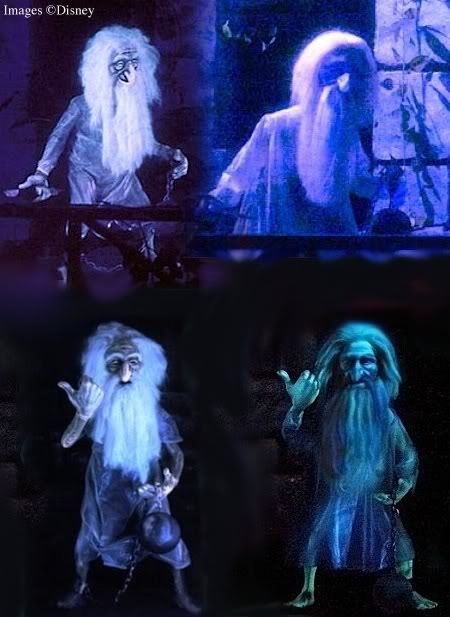
Heh. Notice that somewhere along the line they quietly fixed the original costume discrepancy?
In 1969 he was long-sleeved in the headsman trio and short-sleeved as a hitchhiker. Quelle horreur!
The problem is that the further back you go from this finished Gus figure to his origins on the drawing board, the less he looks like Pliny's ghost. That's the opposite of the case we have seen with others, where the original inspiration is unrecognizable by the time it reaches the ride (The Raynham Lady —> the Attic Bride; the Tedworth Drummer —> the Graveyard Band). Gus started out as a pudgy blob, chained at the neck.

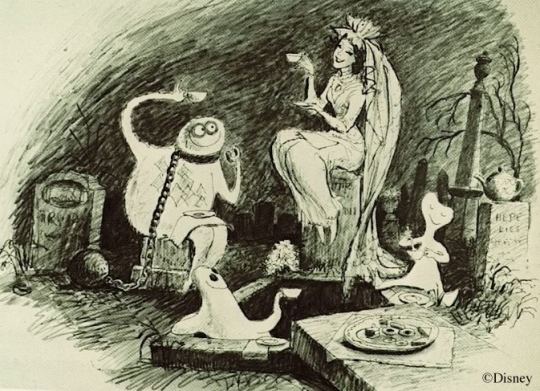
That evolved into the character we know so well from Marc Davis's sketches:


By the way, here we have an example of how good Marc's instincts were. It's obvious today that the hitchhiking ghosts are THE iconic characters of the HM, but how obvious was it in the beginning? There were a lot of candidates, but Davis somehow knew that Gus was the best choice for Mansion mascot, and he gave him that role right off the vampire bat, as we have seen in the early ads he drew.

I like this ad. It's snotty. And look at the acts they had back in the day...
Anyway, he looks like an avocado wearing a Barney Rubble costume. He's still this odd-shaped, pudgy-looking character. When Collin Campbell painted his interpretation of Gus, based on Marc's sketch, "emaciated" clearly wasn't in the job description as far as he could see.
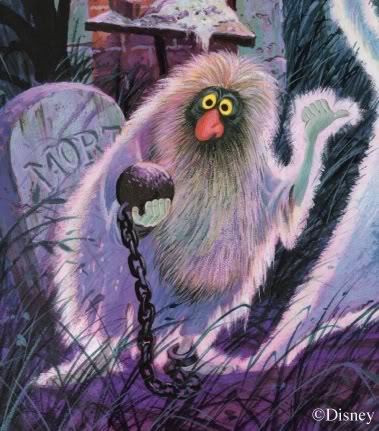
With the maquette figure, we can see that Gus has acquired a real skeleton and is now on his way to scrawny, although he isn't quite there yet.
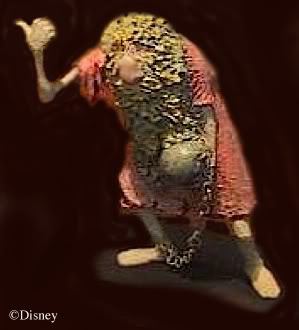
It is only with the final show figure that Gus is unambiguously a skinny old bloke. So if Pliny's ghost is laid under contribution, it would be interesting to learn how it influenced the final design. Maybe we should look over the shoulder of Blaine Gibson or someone like that to see what they were reading.
More Gus Talk
Just for fun. How many of you have never noticed that the Gus of the headsman trio is holding a file, just as he is in one of Marc Davis's sketches. Thanks to the railing in front of him, the file is hard to see, even in many photos.
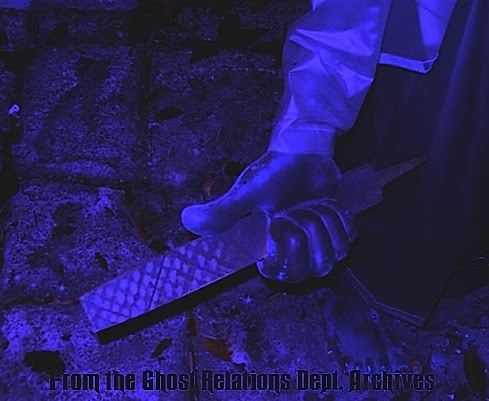
(Tip 'o the hat to Brandon for the photo)
I don't know if it's a coincidence, but all three members of the headsman trio are holding cutting tools appropriate to their professions. "I'm a knight, and with this sword I vanquish evildoers." "I'm an executioner, and with this axe I mete out justice to criminals and enemies of the state." "I'm a prisoner, and with this file—I escape! HA!"
Gus is also the most fleet-footed ghost in the graveyard, zipping from the headsman trio to the hitchhiking trio with lightning speed—too fast to see—and from there into your buggy (33.3% chance) with the same velocity. Speed, he is speed. So...the fastest ghost around is the one wearing a ball-and-frickin-chain. How droll is that?
Originally Posted: Saturday, July 10, 2010
Original Link: [x]
2 notes
·
View notes
Text
The Decapitated Knight
As we slowly wend our way through the graveyard, we continue to stop and to dig here and there, looking for the cultural roots or original inspirations buried beneath the various specters presented to us. We've just finished looking at the band and the hearse tea party, and earlier we looked at the mummy and the operatic pair. So what's say we wander over and take a look at the decapitated knight? Let's see, in our last post we were standing in front of the tea party, so if we cut across, the knight should be easy to find. See him? A head, over on the right hand.
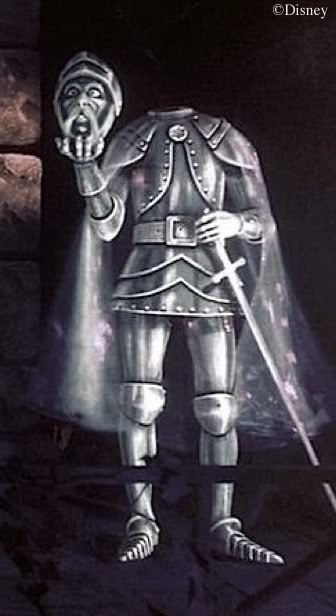
Some might think that the idea of a ghost carrying his head around is an original idea, or if not absolutely original, then an adaptation of the Headless Horseman from The Legend of Sleepy Hollow, a character thoroughly disney-fied in the 1949 film, The Adventures of Ichabod and Mr. Toad. But actually, these kinds of ghosts are quite traditional. There's a little lane in Wortley, England (near Leeds), where the ghost of a Yorkshire nobleman executed during the English Civil War is reportedly seen once or twice a year, carrying his head beneath his arm. In 1760, it was reported that a headless priest was busily haunting a small village outside of Paris. The Christian martyr St. Denis reportedly scared the hell out of his persecutors by appearing as a ghost with his head in his hands and giving it the old boogity boogity boogity. Here's an 18th c. illustration.
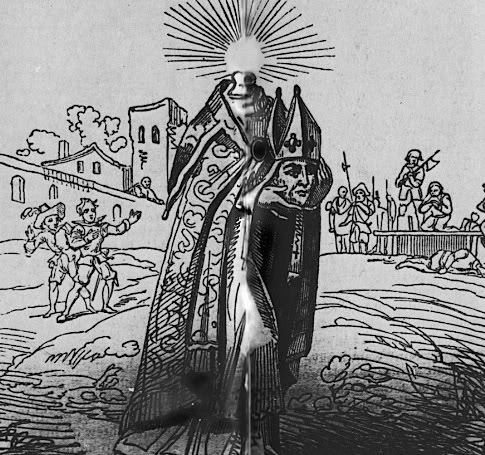
Wow. He looks ready to join the lineup at the Haunted Mansion (except that he's a clergyman, but we'll talk about that in a future post). There is actually a lively tradition of beheaded martyrs behaving in this way (they're called Cephalophores; a big hat tip to ttintagel for drawing my attention to these). Between these firmly attested traditions of headless ghosts and the Sleepy Hollow connection, it's no surprise that both Ken Anderson and Marc Davis created a number of some-assembly-required spirits for inclusion in what became the Haunted Mansion. In fact, Anderson was going to make the Headless Horseman himself the star of the show in one version of his Ghost House.
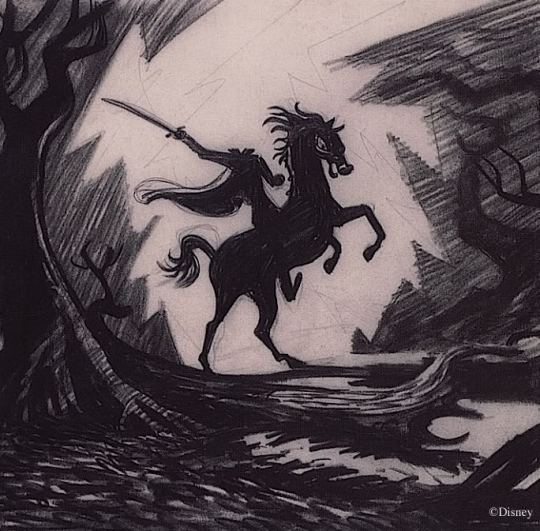
That looks like it could be concept art for the 1949 film, but in fact it's Anderson's sketch of the Ghost House version. The old pumpkin chucker wasn't going to have a monopoly on the gag, however. Anderson also wanted ghosts based on historical characters, and in one script he had Anne Boleyn running around screaming and falling down at the top of the stairs as her wailing head rolled on down toward us. Bumpity bump. (How cool is that.) In other scripts it was a bride character who had a hard time keeping her noggin in place. He also sketched what looks like a decapitated pirate.
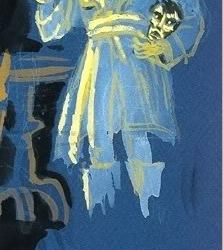
When Marc Davis took charge of things, he apparently liked the Boleyn character and dreamed up a changing portrait in which her husband Henry VIII is haunted by an understandably crabby Anne.
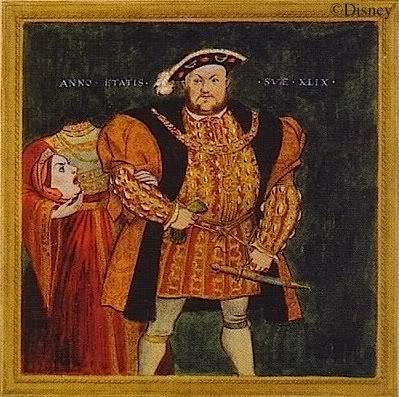
In time it was decided not to populate the Mansion with historical or literary ghosts. There were still plenty of decapitated spooks left in the suggestion box, however. Why not? They're creepy enough even without a famous name attached to them. For his part, Davis thought it would be fun if the afterlife featured topless women:
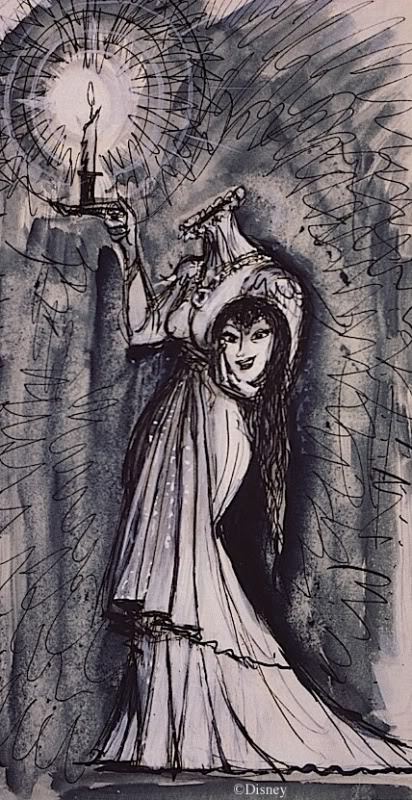
Then there's the Hat Box Ghost, and maybe Madame Leota. After all this, you might conclude that the decapitated knight was just another twist on the same gag. If Anderson could have a pirate; Davis could have a knight, right? No significance to the figure itself, right?
I wouldn't be too sure about that. If you start probing for the origins of the "decapitated knight" figure, you strike paydirt right away. He goes back to Celtic mythology and shows up in medieval literature, most famously Sir Gawain and the Green Knight, which was written about 1350. When I was an English major in college (which was also in the middle ages), everyone was expected to read Gawain at some point. It was like Beowulf; like it or not, you couldn't avoid it. Nowadays I don't know if Gawain is still a regular on the college reading lists. Here's an illustration of the beheaded Green Knight found on the original manuscript of Gawain, probably the most direct ancestor of our DL version. Note that he's holding it on his outstretched hand.
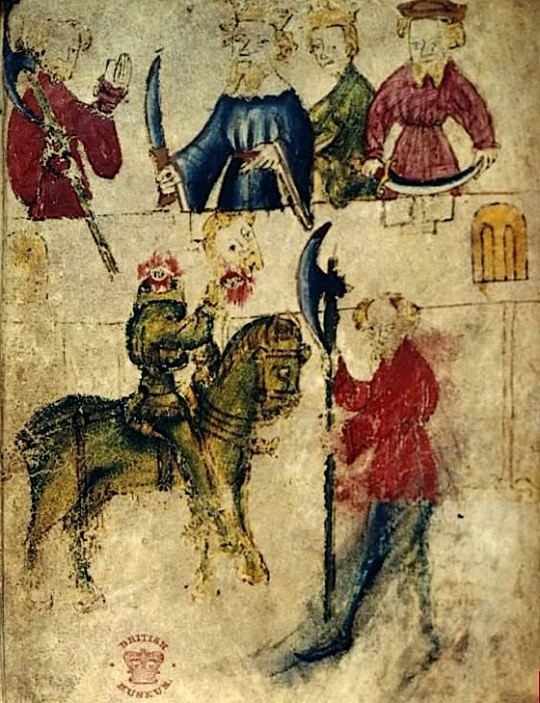
What's weird about the decapitated knight is that he isn't a ghostly figure by any stretch. He's part of a literary motif called the "Beheading Game." Basically, it goes like this:
A stranger shows up at the court and challenges them to behead him, on the condition that he be allowed to do the same at some future point in his own court. The hero of the tale accepts the challenge and beheads the stranger, who does not die but returns home. Later, the hero keeps his promise and goes to the foreign court, encountering numerous tests and trials in the process, opportunities for him to prove his chivalry, loyalty, honesty, etc. The stranger either lets him off the hook or goes ahead and beheads him, after which he cheerfully returns home, none the worse for wear.
The most bizarre thing about this bizarre motif is how popular it was. Sir Gawain and the Green Knight is the most famous example, but the same motif is used in other medieval poems and romances going back to the 8th century—which is basically the same thing as saying that no one knows how old it is, since we start running out of literary sources about that point.
Since the beheadings don't kill anybody in these stories, the presence of the beheading game immediately signals that the literature you're reading is fantasy or myth. Like I said, a popular interpretation is that it goes back to pagan Celtic mythology, probably something about the turning of the year, as the new year slays the old year, only to be slain himself after the passing of a year. Naturally, Freud has his own ideas what this head chopping is all about, and there is no lack of other interpretations. Sir Gawain is amenable to a Christian reading, for example.
Point is, the decapitated knight as a fixture in Western consciousness is not rooted in ghost tales at all but in myth and fantasy. In his origins, he was not a frightening figure.
Marc Davis and the Decapitated Knight
Maybe it's the fact that the knight is not just another random candidate for the "decapitated ghost" gag but the tip of a much bigger and older cultural iceberg that explains Marc Davis's unusual attachment to the character. One might even say stubborn attachment, for when you see the knight in his current graveyard setting you are seeing Marc's fourth attempt to get him into the Mansion. I'm not sure of the order of the other three attempts, so the following account is a little arbitrary as far as sequence is concerned, although there are a few flimsy clues.
In what may be the original concept, Marc presented the knight as a very fierce, stand-alone character. Notice the dead guy in the background. Don't be that guy.
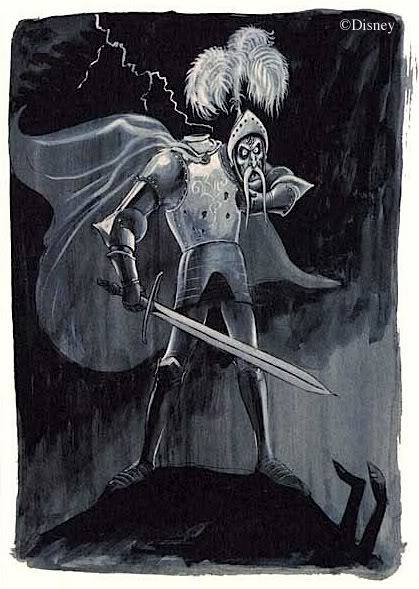
Tender is the knight—NOT.
After it was decided that the graveyard scene should be a jumpin' jamboree and not a horror show (in no small measure due to Davis's own influence), it must have been plain that this scary dude was not going to be invited. They put this artwork on a postcard eventually, and the caption writer practically admits that this portrait is out of step:

(If I were you I wouldn't put too much weight on that "1964" date. Postcard captions are not too reliable.)
Steeerike One!
Like I say, Davis evidently liked the character and re-submitted him as a possible hitchhiking ghost.
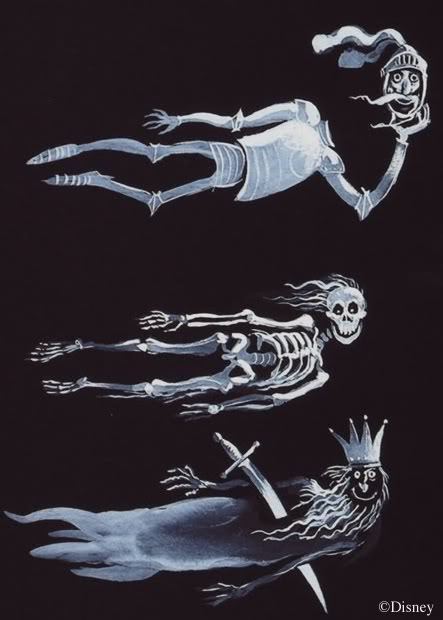
But the HHG gag that they ended up using plays off of the many urban legends about hitchhiking ghosts, who are never terribly distant in time from the unlucky folk who pick them up. You never hear about ghostly hitchhikers who are Roman soldiers or medieval monks, do you? For one thing, you wouldn't understand their language. The three HHG's in the HM are ambiguous: they are certainly a little old-fashioned looking, but not figures from remote antiquity. The decapitated knight wouldn't work as a HHG.
Steeerike Two!
Well, goshdang it, how about the decapitated knight as an opera singer? Yeah, that's it, an opera singer.
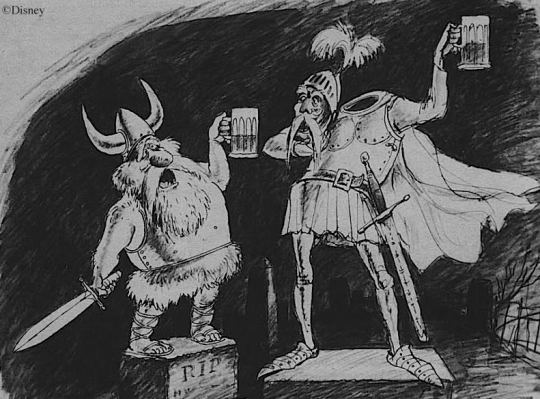
This 1968 drawing is labeled as an opera scene. Get it? "a knight at the opera." Oh, that Marc! This one may be his third attempt since it seems like it got a little further in the process: there's a maquette figure of the knight.

The problem, of course, is that a much funnier opera pair also emerged from Marc's pencil, and there was no doubt who would get the gig.
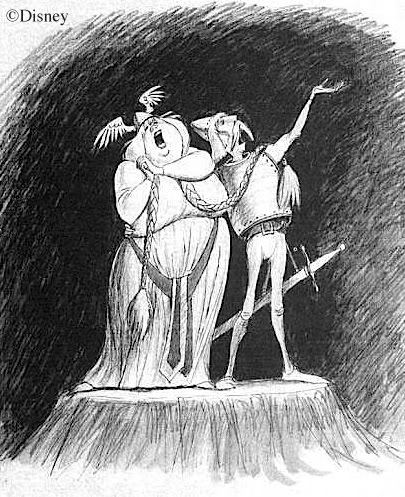
Steeerike Three!
But Marc was not going to give up on the DK. Come on, think. There must be some way to get him in there. What to do, what to do....
*lightbulb*
Hey, wait a sec. Somewhere in that thick pile of HM ideas there's this concept of a pair of ghosts, the Jailer and the Prisoner...

The jailer is already implicitly an executioner as well, what with that mask and all. Well, why not make him specifically a headsman? He could hold a keyring in one hand, and an axe in the other. That's it: make the duo a trio, with the central character relating to the one character as his jailer and to the other character as his executioner.
And so it was.
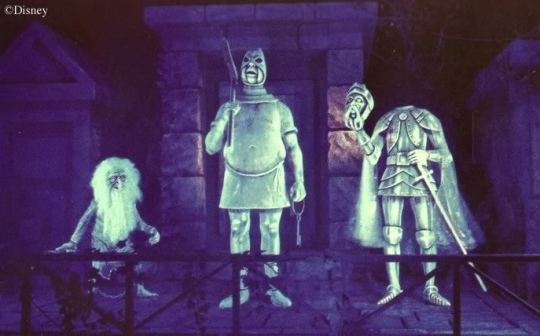
By the way, can someone explain to me why he's always called the "headless knight"? What's that thing he's got in his hand?
Originally Posted: Wednesday, July 7, 2010
Original Link: [x]
3 notes
·
View notes
Text
The Death Coach
Let's continue with our probes into the cultural background of the various ghosts and ghoulies populating the Mansion. Some are mere visual puns and have a thin background (Great Caesar's Ghost, the Phantoms of the Opera), others can be traced back to a single famous ghost (The Brown Lady of Raynham Hall, the Phantom Drummer of Tedworth), and some take their cue from a more general historic or folkloric setting (the Victorian "mummy craze," the numerous legends about ghostly hitchhikers). Sometimes "mere folklore" veers over into full-blown myth, carrying an almost religious portent. That's where we're headed today, as we turn our gaze toward the Hearse Tea Party in the graveyard. Here it is in magnificent 3D, in two sizes, and once again, it's worth it to do the "magic eye" thing, as the depth of field in this one is particularly enjoyable.
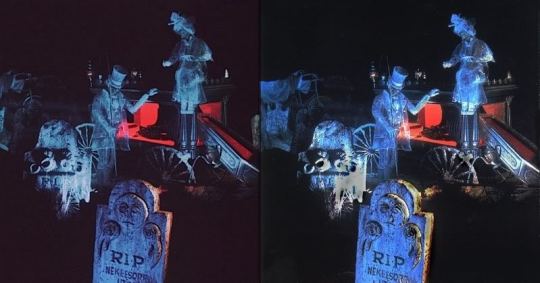

The man in charge here seems to be the coachman.
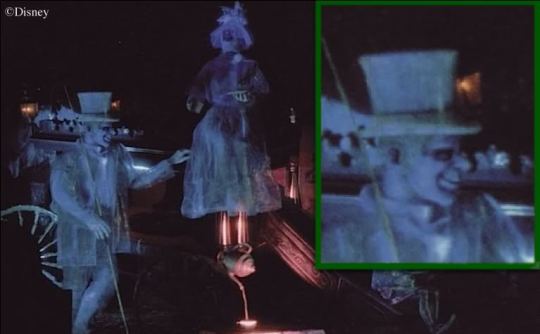
All you have to do is Google "phantom coachman" or "death coach" or the like, and you'll summon up tons of folklore. This is a major ghost. He's a fully mythological figure in Irish folklore, the Dullahan, driving the Cóiste Bodhar ("coach-a-bower"). The Dullahan is a headless coachman who works in coordination with the Banshee and takes you away when you're about to die. Interestingly, it is widely agreed that the most satisfying treatment of this figure in modern pop culture is in the 1959 Disney film, Darby O'Gill and the Little People. (Mansionites particularly enjoy the Banshee in this film because a couple of its wails were either added to or taken from the Disney sound library and emigrated from there into the Haunted Mansion's Corridor of Doors.)
Here he comes...


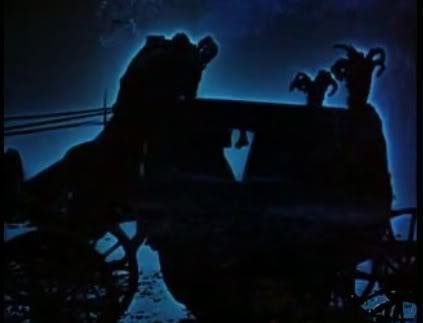
Get in.
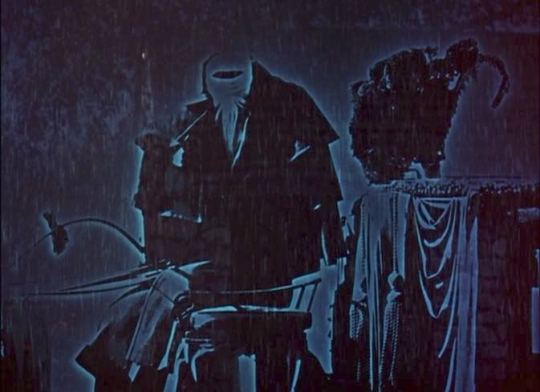
Another interesting cinematic treatment of the Death Coach is in F.W. Murnau's classic, Nosferatu (1922). En route to the castle Dracula, Jonathan Harker is whipped across Transylvanian no-man's land in a phantom coach. This suggests that poor Jonny is in some sense leaving the land of the living and passing over into the land of the dead.
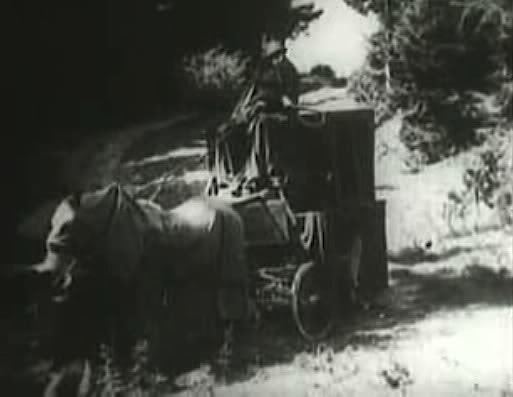
Check HERE for another 1921 treatment of the Death Coach, this time in a Swedish film.
Plenty of "real" phantom coaches have been reported. Part of the ghostly doings at Borley Rectory ("The Most Haunted House in England") involve unseen coaches and thundering hoofbeats passing by, or glimpses of a ghostly coach with a headless driver. The Edinburgh Royal Mile has its very own phantom coach, they say.
The phantom's appearance varies. Besides the headless coachman, there's a monstrous one, a Grim Reaper-like skeletal one, and a fairly "normal" looking one. Asked to create a Phantom Coachman mask/wall sculpture, the folks at Dynamic Design International (who have done some work for Disney) came up with this as the classic look:

Likewise, the vehicle varies. Usually it's a proper black stagecoach, but often in popular depiction it's a hearse.
Was any of this in the background as Marc Davis designed his tea party ensemble? Alas, the paper trail is much thinner this time. His concept sketch looks pretty much like what we ended up getting.
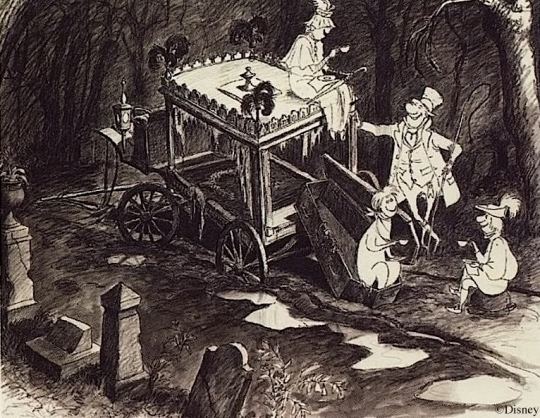
However, there are depictions of the Death Coach in pop iconography that are remarkably similar to Davis's graveyard hearse in appearance. This is from a 1954 comic book:



If you have your parents' permission, you can read the rest HERE, but be forewarned: that stuff will rot your brain. Anyway, this is all fair game, as we have already seen that Davis was not above taking inspiration from horror comics.

Davis's driver is a lot less gruesome, but he is, literally, a phantom coachman, and he's presumably the one who brought these folks to the graveyard (i.e., the place of the dead). The similar hearse dropping off guestly ghosts in the ballroom originally was going to have a friendly driver too, to judge from Davis's concept art.
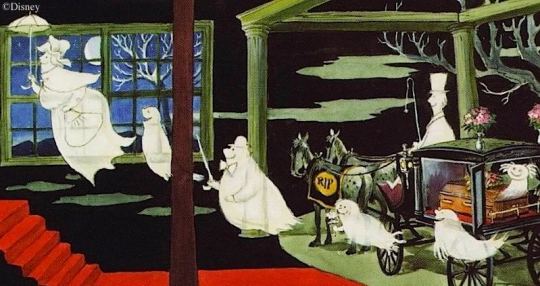
Essentially, what we've got is a cheerful Charon. That's definitely how Collin Campbell read Davis's graveyard drawing when he did the cover of the "Story and Song" album. (You'll note that Collins combines elements from both of the Davis concept pieces above.) The phantom is providing a taxi service in this painting that is not essentially dissimilar to his function in the scarier treatments.

Davis obviously wanted to get away from the scary phantom coachman and make him a light, comic figure. Indeed, the Davis/Collins coachman looks like a cross between Mr. Magoo and W. C. Fields. Other Disney artists have also treated this character and this topic. One interesting example is on the back cover of the 1970 Magic from the Haunted Mansion souvenir book. That artist clearly interpreted the graveyard hearse as the Death Coach:

When Imagineers in the 90's kicked around ideas for improving the Load area, one of the new concepts called for a full-blown Death Coach in a large window. Notice that once again it's a hearse, not a stagecoach, but this time the Grim Reaper version of the coachman is used:

It's a thinner trail this time, but I'm willing to put down the coachman at the Hearse Tea Party as another spook with solid roots in established ghost lore. It is most curious that we humans are consistently interested not only in the afterlife but in the means of transport from this world into that one. When we're not talking about angelic escort by walking or flying, we're seeing visions of boats and coaches. A carriage approaches, to take you into the boundless realm. Part of the journey is the mode of transportation itself, it seems. And for that last trip, there is no longer any need to pull down on the safety bar.
Originally Posted: Sunday, July 4, 2010
Original Link: [x]
0 notes
Text
The Phantom Five and the Drummer of Tedworth
It is well known that the Haunted Mansion Imagineers did a lot of research into ghost lore, looking for ideas. In at least one version of his 1957-58 Ghost House, Ken Anderson populated it with famous villains and spooks from history, literature, and cinema. When Rolly Crump and Yale Gracey took over the reins of the project in 1959, they too read a lot of ghost stories, according to Rolly himself. The fact that they were doing this kind of research even made it into official press releases.

Occasionally, if we're lucky, it's possible to trace something in the HM back to its original inspiration in ghost lore. A good example is the Brown Lady of Raynham Hall, whom we have met before, once upon a nightmare. She first inspired a sketch by Ken Anderson which then wandered through Marc Davis's imagination and eventually emerged as the attic bride.
Another good example is the Phantom Drummer of Tedworth, the first really famous poltergeist in England. He was a pretty spectacular ghost, causing quite an uproar back in the 1660's. What we know about the Phantom Drummer comes primarily from Saducismus Triumphatus: Or, Full and Plain Evidence Concerning Witches and Apparitions, a two-volume set published in 1681 by Joseph Glanvil. The book was a seminal early investigation into supernatural phenomena. (Incidentally, it was also an excellent example of early printing, a very handsome edition for its day.)


As Alice says, what is the use of a book with no pictures in it? Not to worry; as you can see, Glanvil was illustrated.

That's the Phantom Drummer of Tedworth in the upper left corner.
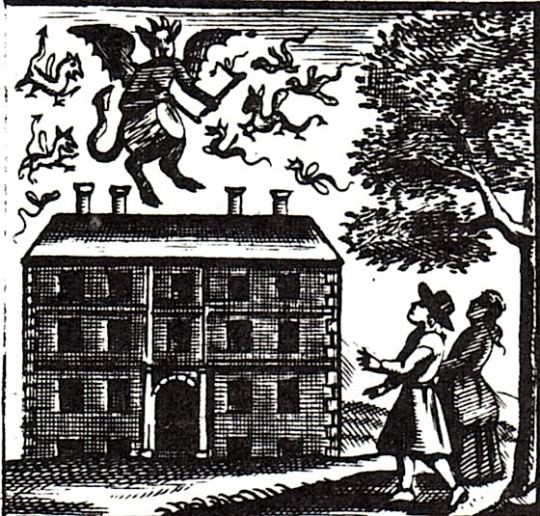
The Imagineers thought about bringing this famous spook to the Mansion, and Marc Davis did a concept sketch, clearly labeled "The Phantom Drummer of Tedworth." Marc wanted the drum sound to be a human heartbeat.

They didn't use this ghost, of course. Or did they? Notice the band uniform? When the idea of a graveyard band was first being kicked around, the drummer was much more of a central character in the artwork. He had a quasi-quasimodo sidekick just to hold up his drums.

As the band idea took shape, the ensemble expanded, and the drummer became less of a star.He still had his flunky, however, until quite late in the game:

But when the drum-bearer was ditched in favor of a floutist, the fate of the drummer was sealed.He was going to be viewed as just another player in the band.


Maybe that explains why he looks so p.o.'d. Actually, I've always thought he looks a little like Charlie Watts.
It's the mouth. Look, if Keith can do Disney movies....

Besides the illustration in Glanvil, there's another noteworthy rendering of the PD of T, dating from the 19th c., a satirical sketch by George Cruikshank. Cruikshank was a famous caricaturist, perhaps best known for illustrating Charles Dickens' books.
Marc Davis would likely have been familiar with Cruikshank's work.

It's interesting to compare Cruikshank's ghostly drummer with Davis's artwork.
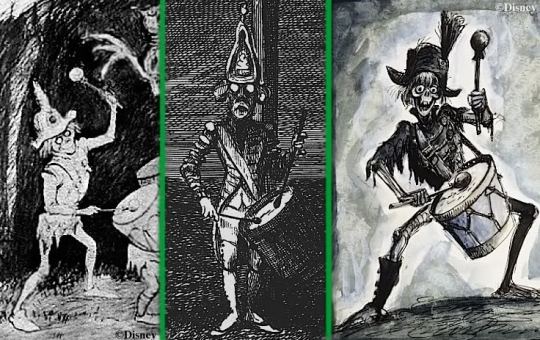
Just as it's interesting to compare the original Glanvil illustration. I wonder if the horns and ears of the little devil may have suggested the style of hat Marc used in his sketch.

Whatever contribution Cruikshank's sketch may have made, when you're looking at that diabolical imp flying over the roof in that old engraving, you're probably looking at the original spark that eventually gave us the graveyard band. The Phantom Drummer became the Phantom Five.
Originally Posted: Saturday, July 3, 2010
Original Link: [x]
4 notes
·
View notes
Text
Opening Day Photo

[Edited and updated, September 13, 2011.]
This really should have been included with the previous post, but it's special enough to justify its own. Reportedly, there was very little fanfare accompanying the Mansion's opening, even at the "official" one on Tuesday the 12th. It's hard to find any historical relics. This photo has been circulating for years, but as far as I know, I was the first to try to make a systematic case that it's an opening day photo. For what it's worth, here's the argument:
It's stamped "August 1969" on some copies.
It's a very professional photo, not a tourist snapshot. Someone hired someone to take this shot.
It's probably not staged. If it were, why would the photographer have included the Cast Member at the turnstile near the center of the shot? He adds nothing to the photo; in fact, he's a distraction. He is, however, correctly placed, ready to collect tickets.
It appears to be a special occasion. The Cast Members standing like sentinels out front are unusual.
The Mansion has not yet opened this day. In even the slowest moving lines, the majority of people face in the direction of movement, but not here. These people are waiting for the Mansion to open, not waiting for their turn on a ride already in operation.
You can see no children in line, and only one or two teens. That could well be because the ride's contents were still unknown, and no one knew yet if the ride was too scary for children.
I used to think that the occasion that corresponds best with all of the above would be the morning of Tuesday, August 12th, the "official" opening day, but in September 2011, "ww12345" at Micechat posted this clipping from the LA Times, dated 8-12-69:

So the photo must have been taken before the 12th.It must go back to the "real" opening over the previous weekend, probably the 9th or the 10th.
Incidentally, it's a fabulous photo. The building looks alive and menacing. The photographer resisted the temptation to get far enough back to pick up the eye-catching cupola and instead came in low and close, so that the building corner juts out like the prow of a ship bearing down on you. Nice.
Originally Posted: Friday, July 2, 2010
Original Link: [x]
16 notes
·
View notes